Synology DS225+ NAS Review – Should You Buy?
The Synology DS225+ is a 2-bay desktop NAS released in 2025 as a refresh to the DS224+, aimed at home users, remote workers, and small teams needing centralized storage, backup, and multimedia functionality. It retains the Intel Celeron J4125 processor, a quad-core chip with integrated graphics, and includes 2GB of DDR4 non-ECC memory soldered to the board, with an available slot to expand the total to 6GB. Connectivity consists of both a standard 1GbE port and a 2.5GbE port, along with dual USB 3.2 Gen 1 ports for external drives or UPS devices. The chassis is compact and passively efficient, consuming less than 17 watts under load and producing under 20 dB(A) of idle noise—well-suited for environments where silence and energy efficiency matter.
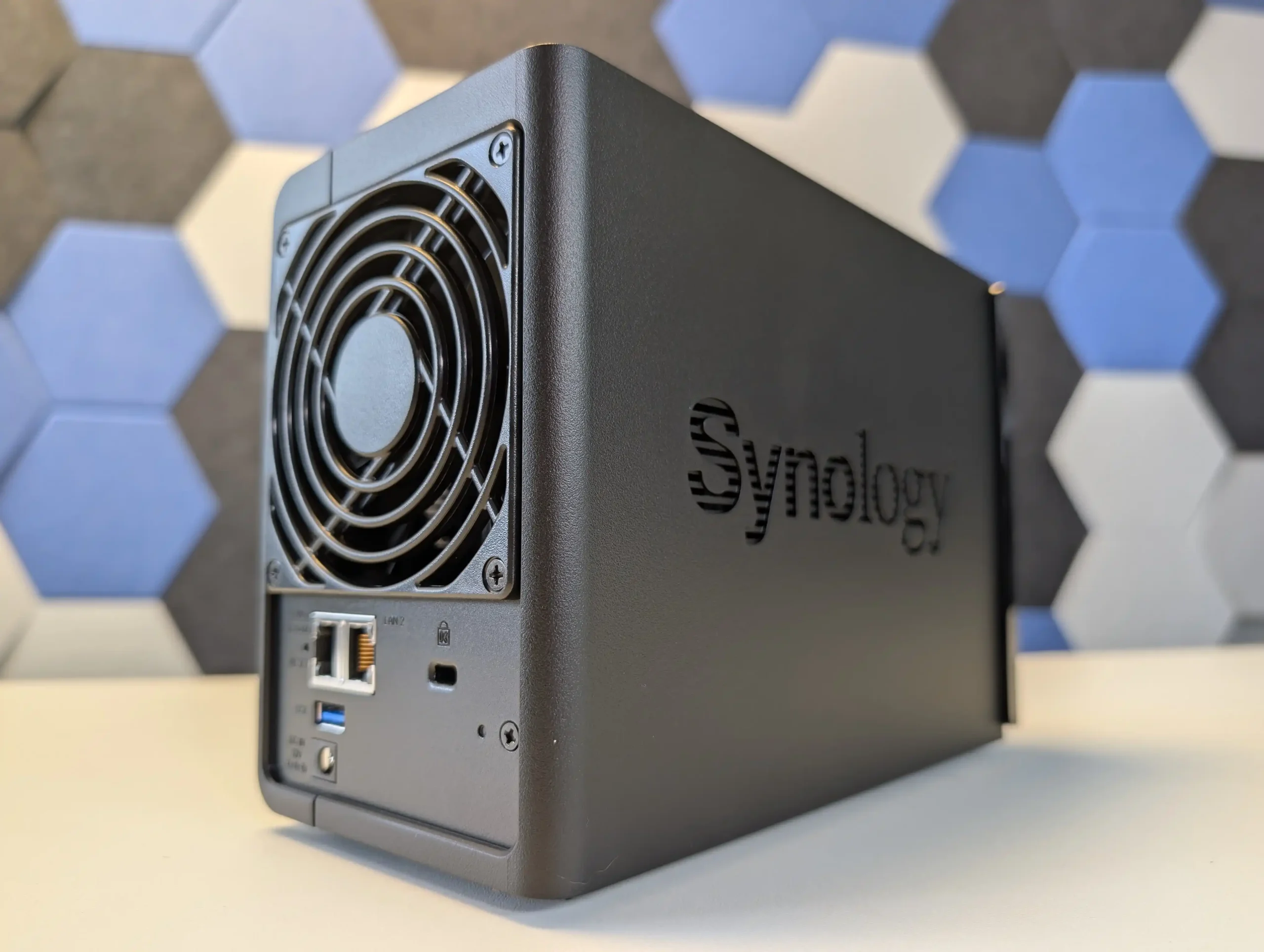
The DS225+ runs DSM 7.2, Synology’s proprietary NAS operating system, and supports the full catalog of Synology applications for backup, file sharing, collaboration, and even light virtualization. Users can take advantage of tools like Active Backup, Hyper Backup, Surveillance Station, Synology Drive, and Virtual Machine Manager, with support for Btrfs and SHR offering additional flexibility. While the DS225+ delivers a solid turnkey experience for typical NAS users, its dated CPU, limited upgrade path, and increasingly restrictive drive compatibility policy raise questions about long-term value and competitiveness in the current NAS landscape. This review will examine five key advantages that justify its place in the market—and five potential drawbacks that could sway buyers toward alternatives or delay a purchase.
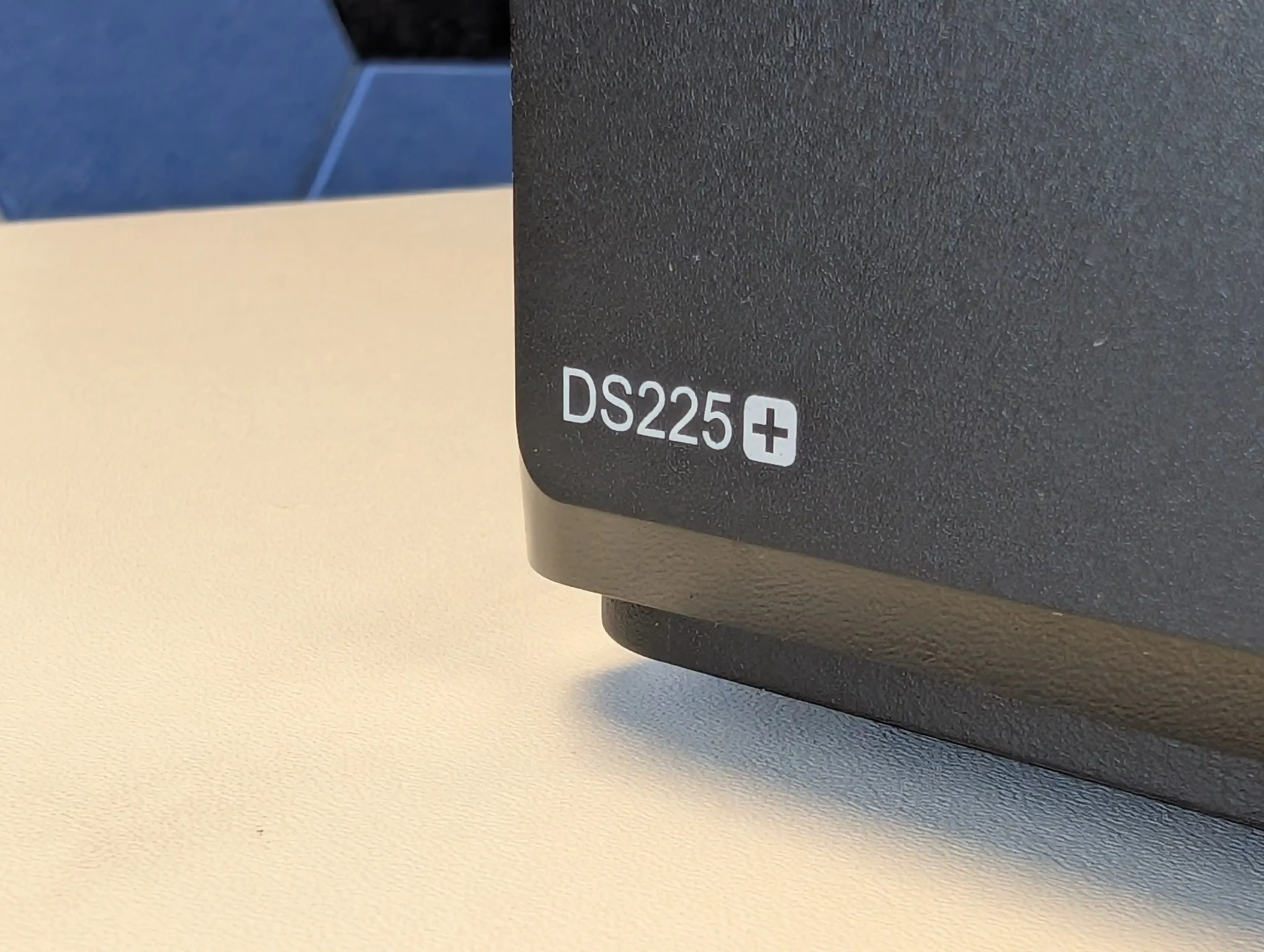
Where to Buy a Product





![]()
![]()

VISIT RETAILER ➤






![]()
![]()

VISIT RETAILER ➤






![]()
![]()

VISIT RETAILER ➤






![]()
![]()

VISIT RETAILER ➤
|
Synology DS225+ NAS |
|
|
Amazon in Your Region for the Synology DS225+ NAS @ $339 |
B&H for the Synology DS225+ NAS @ $339.99 |
Feature-Rich DSM Software and Integrated Services
One of the strongest arguments in favor of the DS225+ is its inclusion of Synology’s DiskStation Manager (DSM), widely recognized as one of the most polished NAS operating systems on the market. DSM 7.2 runs natively on the DS225+ and includes a comprehensive suite of first-party tools designed for file management, backup, synchronization, collaboration, and multimedia.
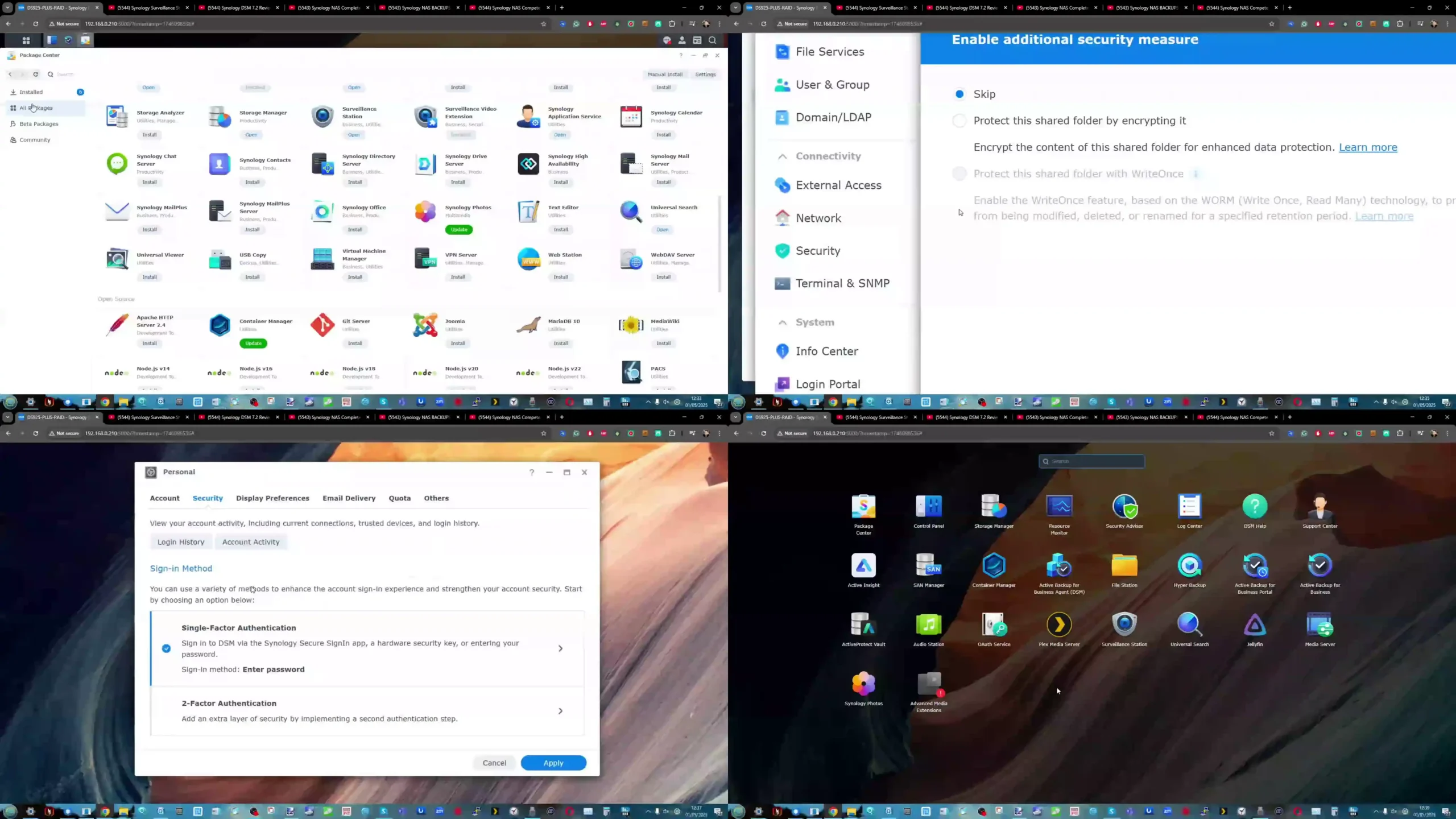
Applications such as Active Backup for Business enable full system imaging and granular backups for Windows and Linux clients, while Hyper Backup supports encrypted, versioned backups to remote Synology NAS, USB drives, or public cloud platforms. These tools are license-free and integrate tightly with DSM’s centralized control panel and task scheduler, making them practical for individuals and small teams alike.
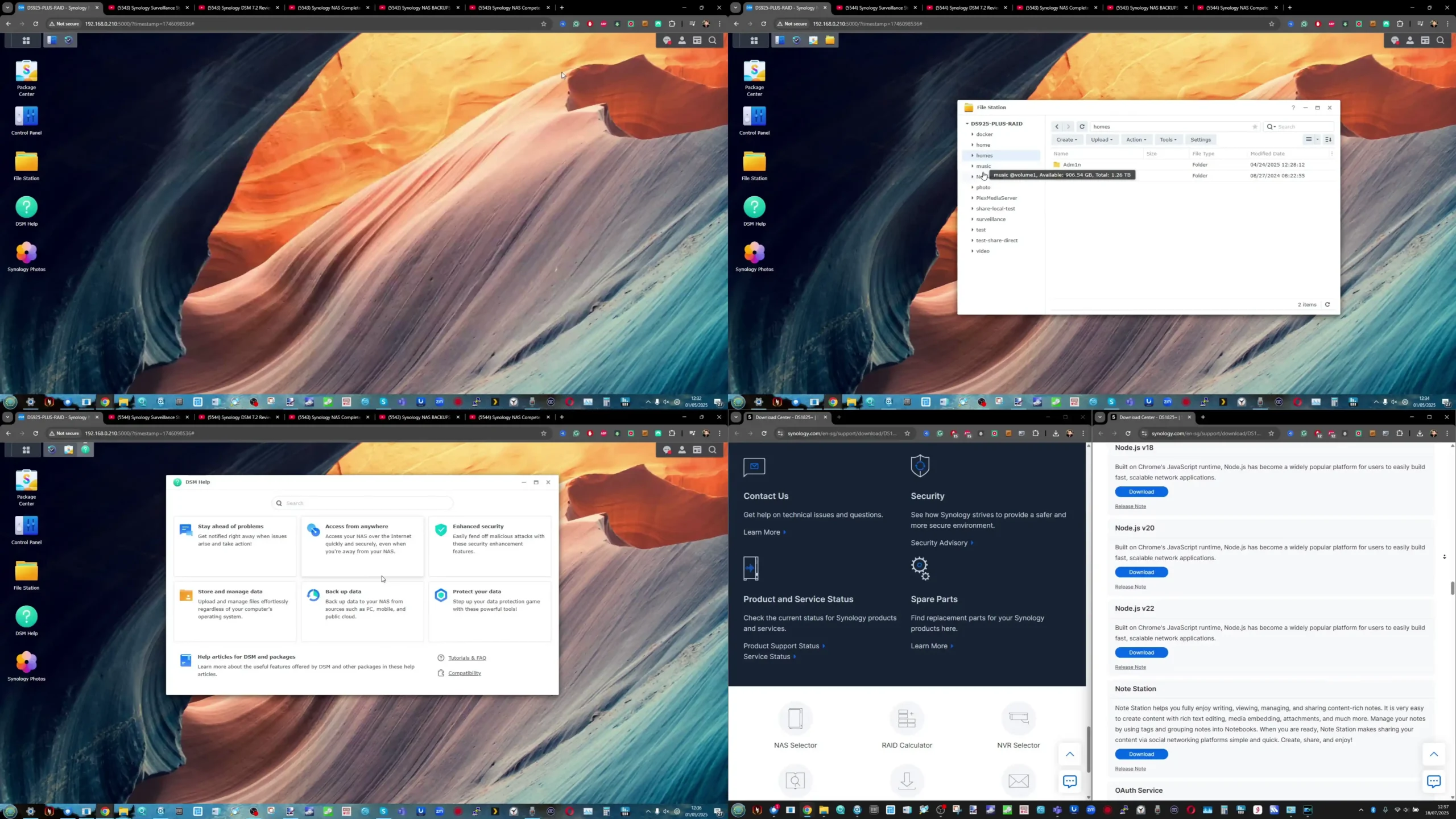
The DS225+ also supports Snapshot Replication, allowing users to create fast, low-overhead restore points across shared folders or entire volumes. This is especially useful for protecting data against accidental deletion or ransomware threats. Multimedia services such as Synology Photos and Video Station are included, with support for AI-driven features like facial and object recognition—provided the RAM is upgraded to at least 4GB.
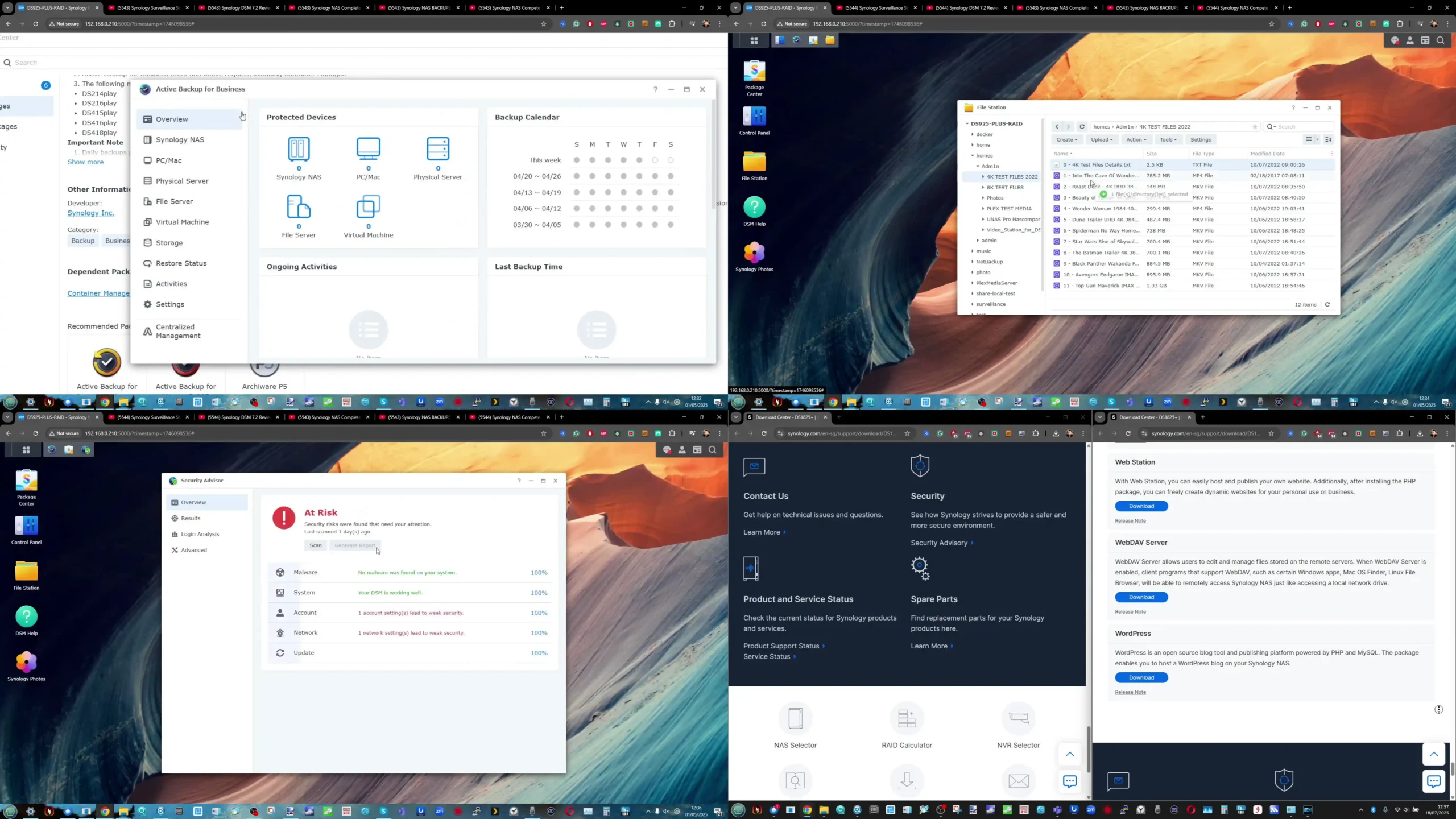
Additionally, users can deploy lightweight productivity services such as Synology Drive, Chat, and Office, all of which are accessible via browser or mobile apps. While the DS225+ is limited to 2 bays, it still benefits from full access to Synology’s software stack, giving users enterprise-grade functionality in a compact and relatively affordable unit.
Locked Drive Compatibility Limits Flexibility and Upgrade Options
A major drawback of the DS225+ is Synology’s increasingly rigid stance on drive compatibility, particularly with its 2025 product generation. At launch, the DS225+ only officially supports Synology-branded HDDs and SSDs, including the HAT5300 and SAT5200 series. While these drives offer solid performance and enterprise-grade validation, they are often more expensive than third-party alternatives and far less widely available in retail markets.
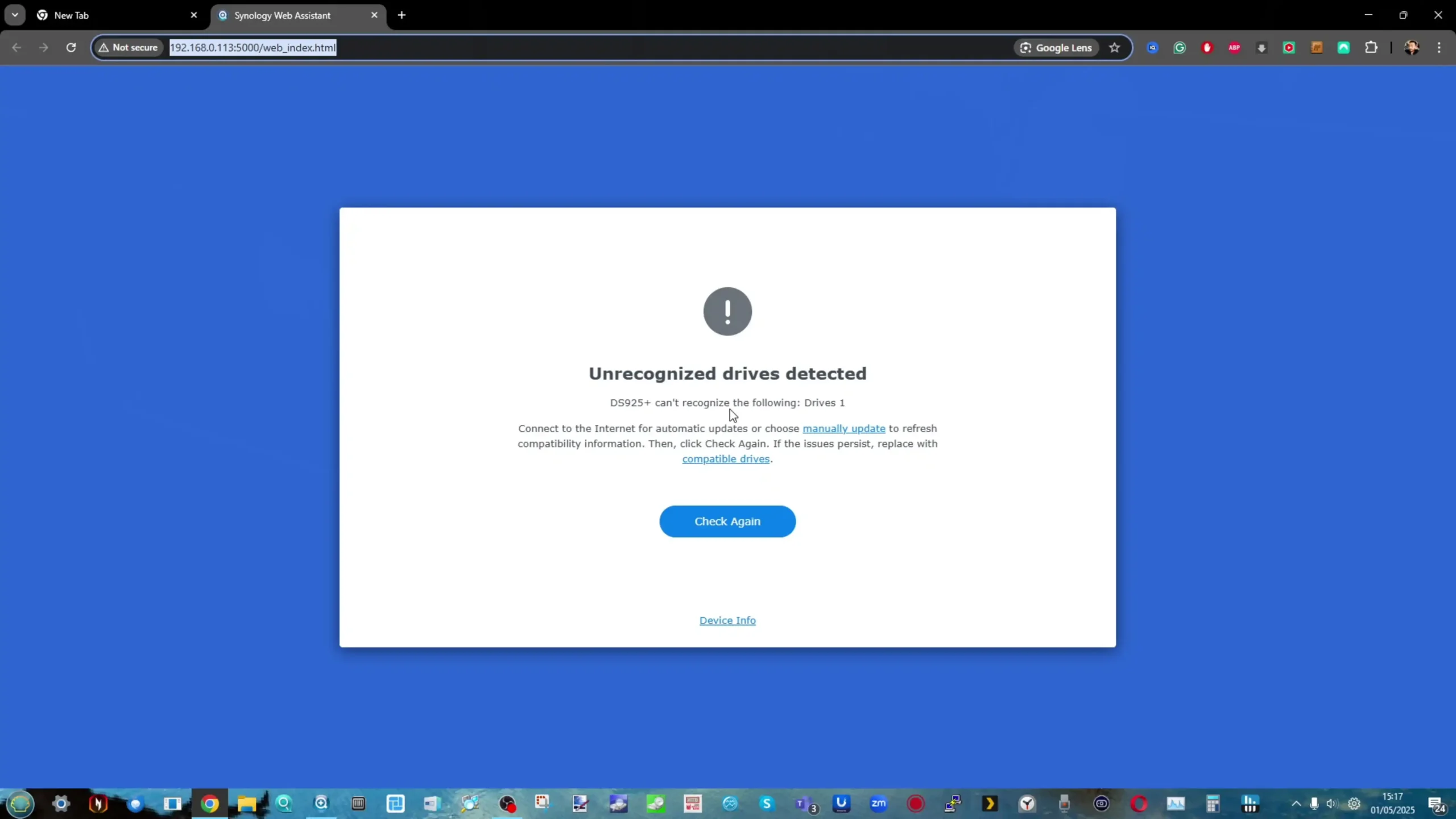
More critically, DSM may block or degrade functionality if users install unsupported drives—such as WD Red, Seagate IronWolf, or Toshiba N300—even if those drives meet technical requirements. This includes disabling RAID creation, expansion, and in some cases even volume initialization.
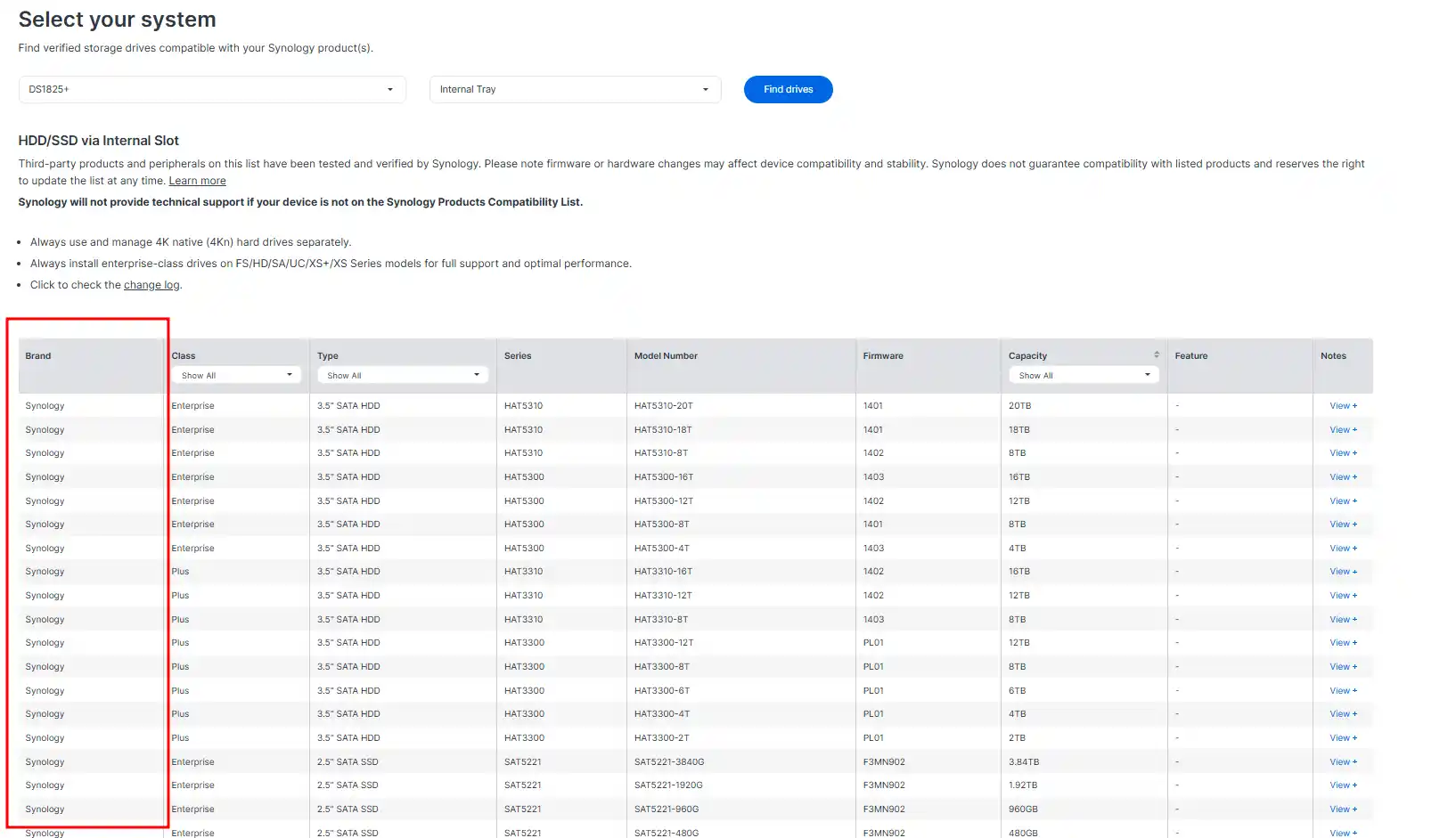
For users hoping to reuse drives from older systems or build cost-effective arrays with commodity drives, this presents a serious limitation. The policy effectively turns the DS225+ into a semi-proprietary system where basic RAID features and DSM warnings depend on purchasing Synology-approved hardware.
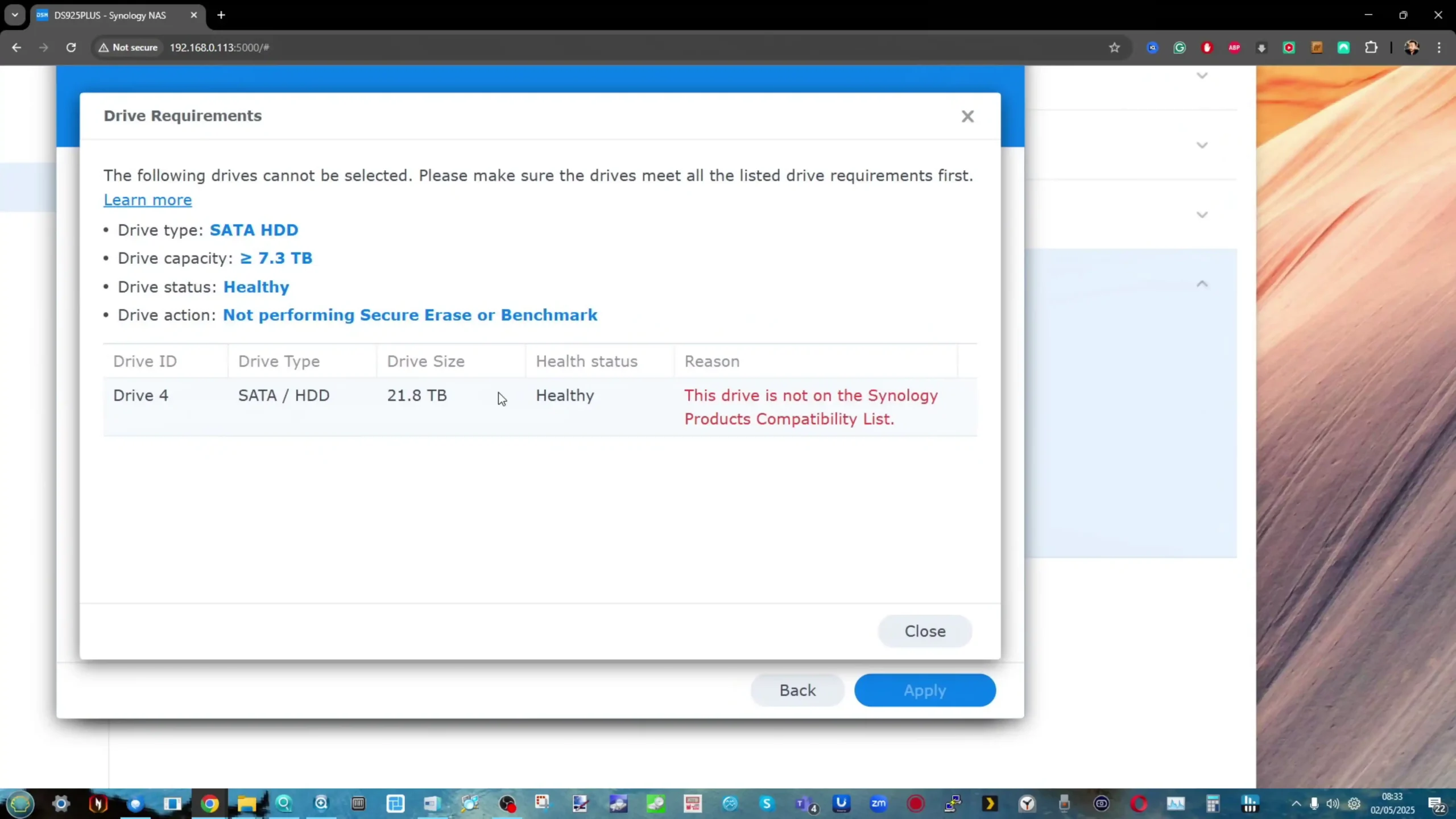
While it’s possible the compatibility list may expand in the future, as of July 2025, this restriction creates significant friction for DIY users or small offices managing mixed storage fleets. It also undermines the flexibility that has traditionally been one of Synology’s key advantages over more locked-down storage ecosystems. Users seeking the freedom to choose drives based on price, warranty, or local availability will find the DS225+ ecosystem increasingly restrictive.

Exceptionally Low Power Consumption and Quiet Operation
The DS225+ is particularly well-suited for 24/7 deployment in environments where power efficiency and noise are concerns, such as home offices, media rooms, or shared living spaces. In real-world usage, the system consumes just 16.98 watts during access and drops as low as 6.08 watts in HDD hibernation, making it one of the most energy-efficient 2-bay NAS systems in its class.
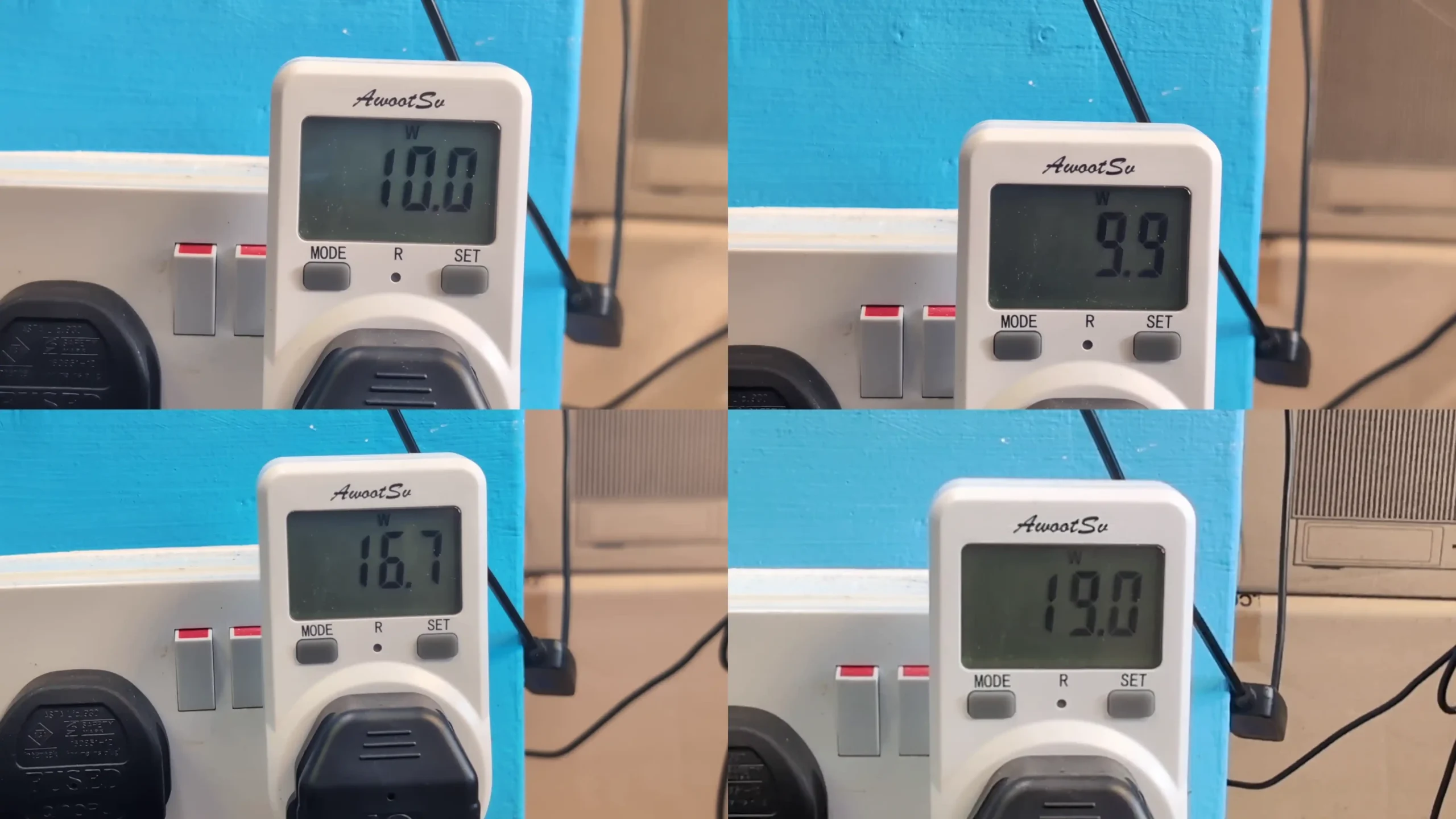
This low draw is aided by the efficient Intel J4125 processor and a single 92mm system fan that manages thermals without overcompensating. During testing, the DS225+ maintained component temperatures of 32°C–37°C even under sustained moderate CPU and disk activity, confirming that the chassis design and airflow are well-optimized for the thermal envelope.
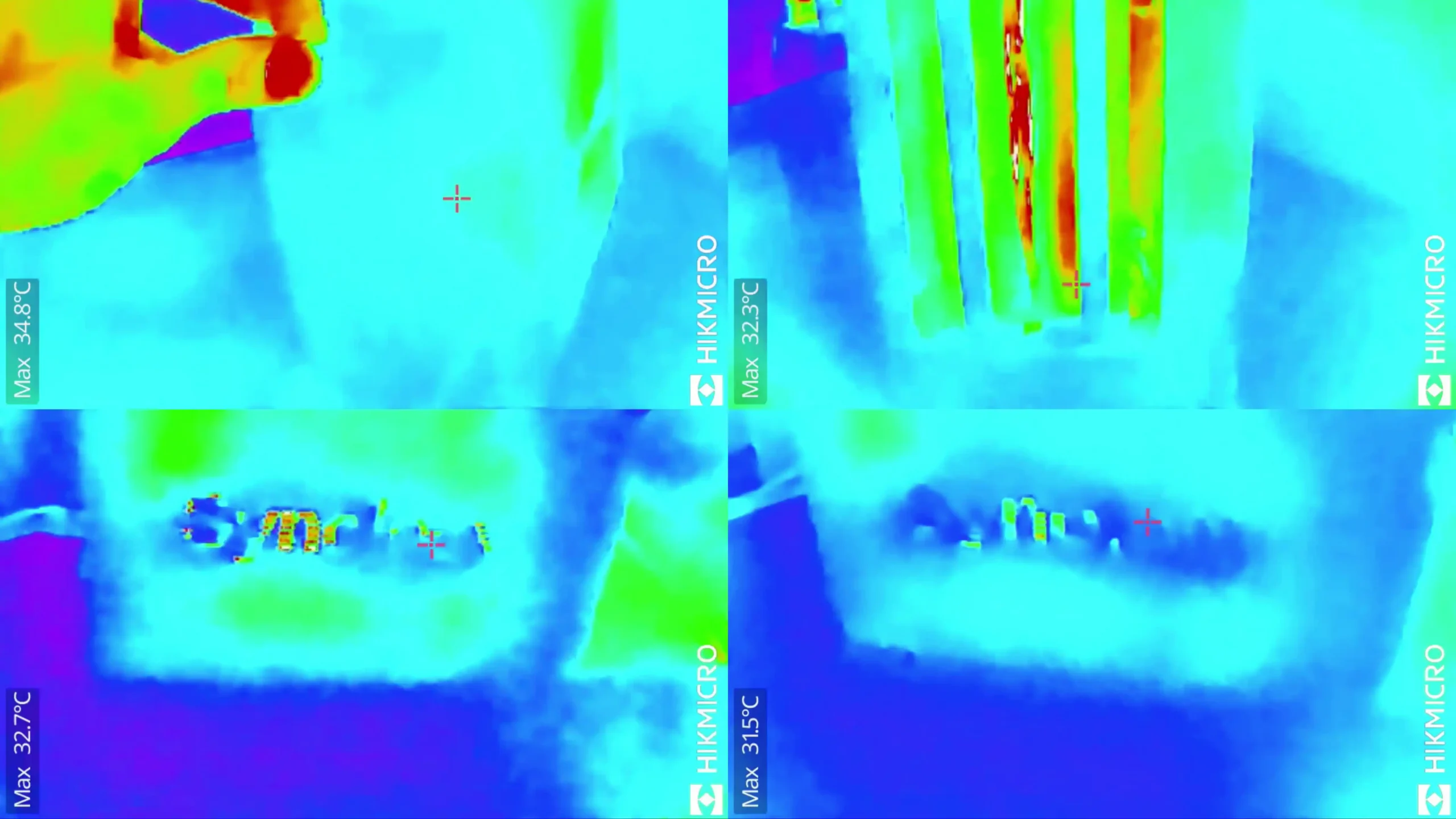
In terms of acoustics, the DS225+ is also ideal for quiet setups. It produces just 19.6 dB(A) of noise at idle—barely above ambient background levels—and remains quiet even under drive access or medium fan profiles. This makes it an appealing choice for use in proximity to desks, entertainment setups, or even bedrooms, without becoming a source of distraction. The adjustable fan modes (Full-Speed, Cool, and Quiet) can be fine-tuned in DSM, allowing users to prioritize either silence or cooling based on workload and ambient conditions. For users who want a reliable NAS that can operate continuously without noticeable noise or energy penalties, the DS225+ delivers an efficient and unobtrusive experience.
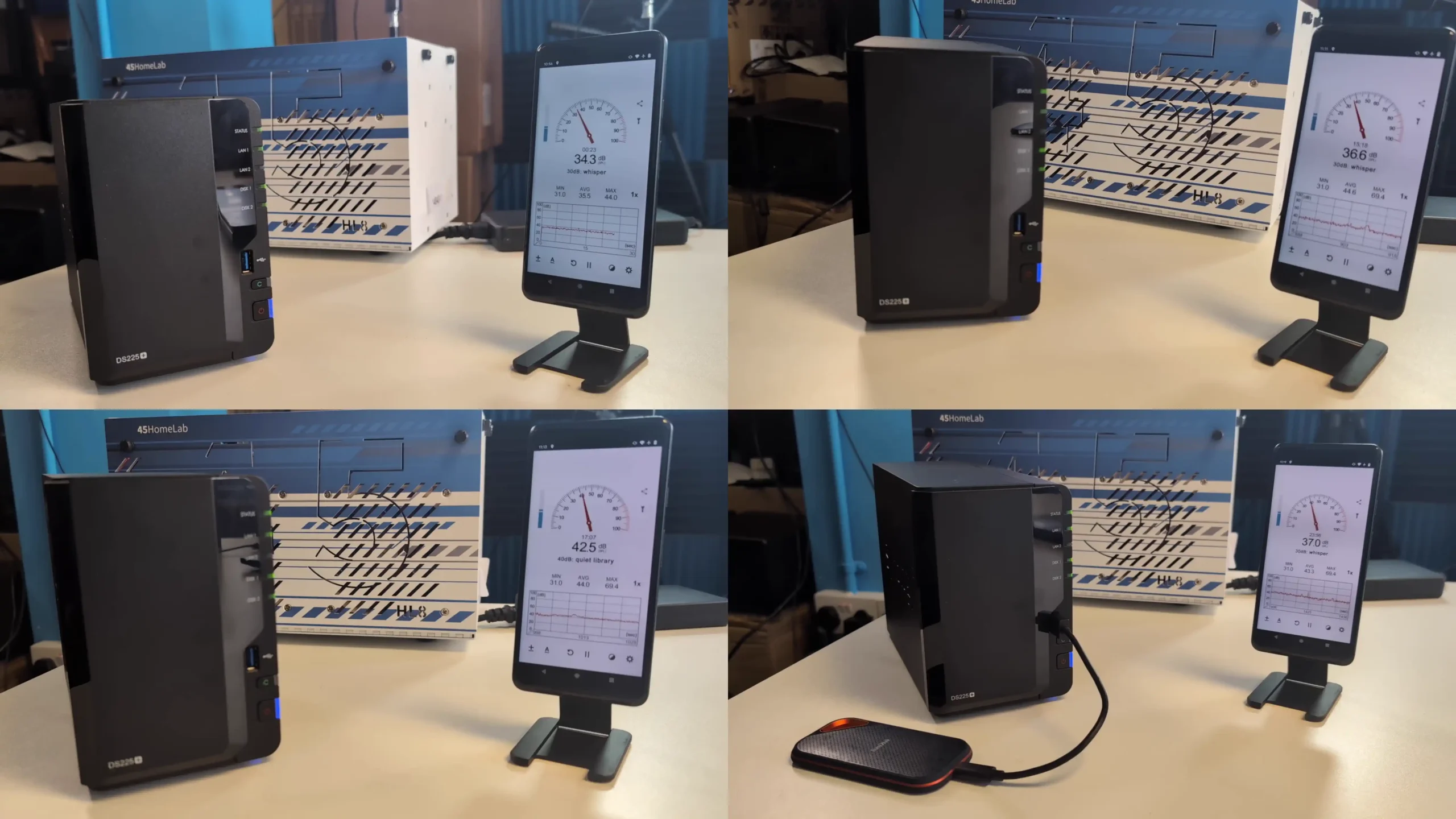
Aging Intel Celeron J4125 CPU Limits Future-Proofing
The DS225+ continues to use the Intel Celeron J4125, a 4-core, 4-thread processor first launched in late 2019. While it still performs adequately for DSM tasks, light media streaming, and small office workloads, it is now well behind newer processor architectures in terms of efficiency, instruction set support, and overall responsiveness.
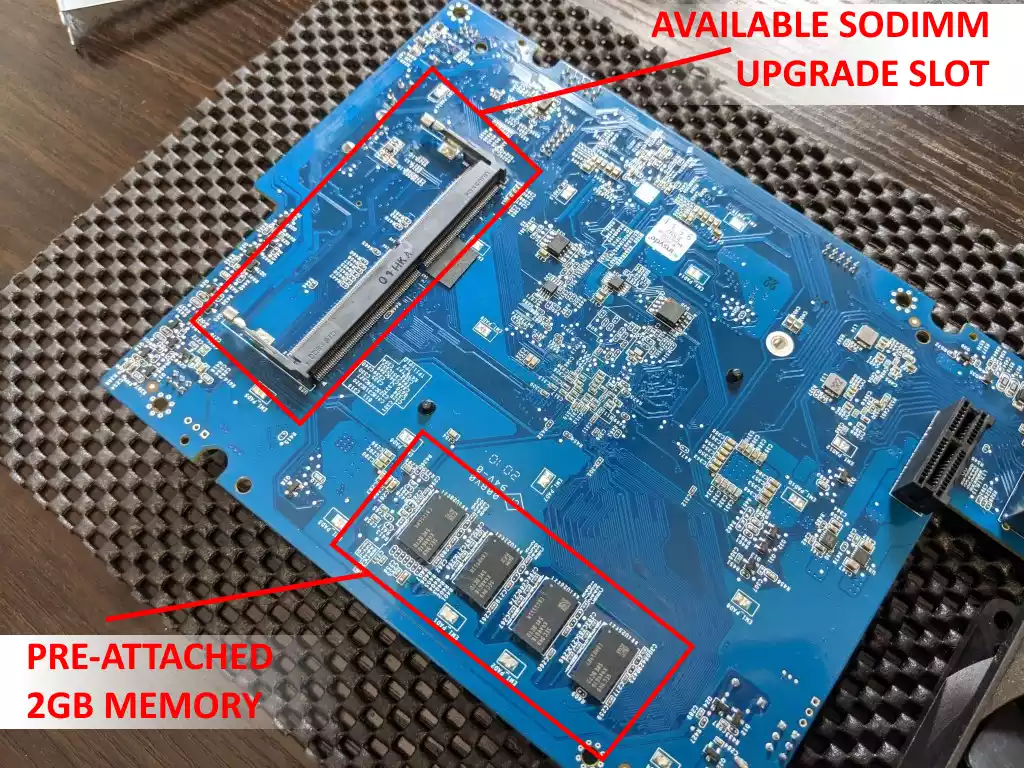
Competing NAS units released in 2024 and 2025 have moved on to Intel N-series, Jasper Lake, or even embedded AMD processors, many of which offer better performance-per-watt, additional cores, and support for modern instruction sets such as AVX2 and higher memory bandwidth. In contrast, the J4125’s dated 14nm Gemini Lake Refresh architecture lacks modern features and could begin to show its age sooner, especially under multitasking or when running additional DSM packages concurrently.
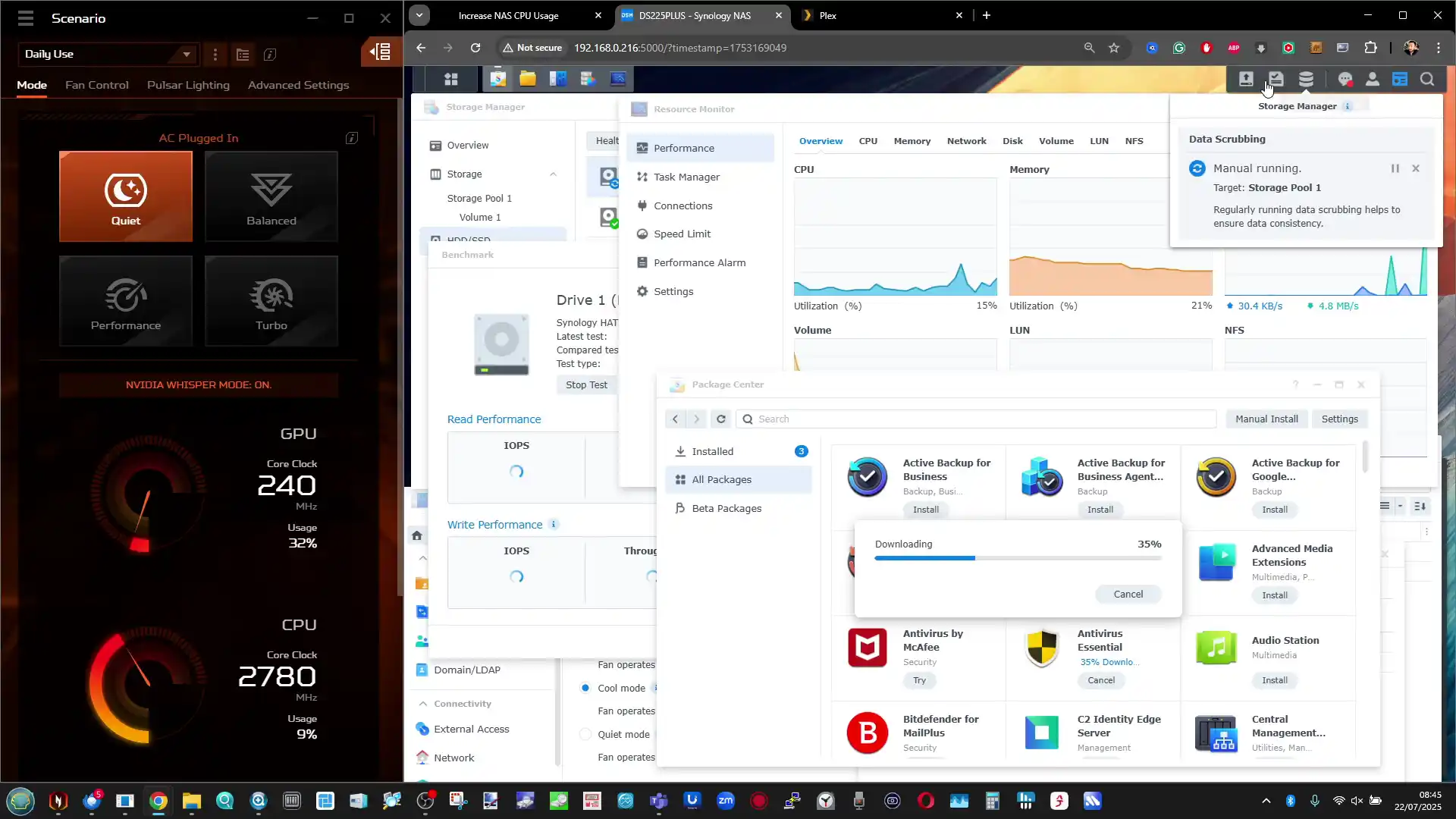
Although the DS225+ is not intended for heavy virtualized workloads or media encoding, the use of such an older CPU architecture restricts its growth potential. During testing, even modest activity such as Surveillance Station recording or Synology Drive sync tasks caused the CPU to reach 60–70% utilization, leaving little room for additional services. Docker and Virtual Machine Manager are supported, but their use is constrained by both CPU headroom and the device’s limited memory ceiling. For users expecting to scale their usage over the next 3–5 years, the DS225+ may struggle to keep pace as DSM continues to evolve and introduce more background services, analytics, and real-time processing demands.
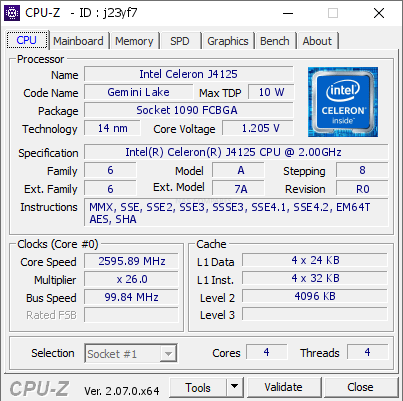
Integrated Graphics for Light Transcoding and Multimedia Tasks
A notable advantage of the DS225+ is its use of the Intel Celeron J4125, a quad-core x86 processor that includes integrated Intel UHD 600 graphics. While this is not a new CPU, the presence of onboard graphics enables hardware-accelerated video decoding and transcoding, a feature that’s become less common in newer NAS systems using ARM-based or non-iGPU x86 processors. For users planning to run Plex or Jellyfin, this hardware acceleration allows the DS225+ to handle light 1080p transcoding tasks—useful when streaming to devices with limited codec support or over constrained network connections.
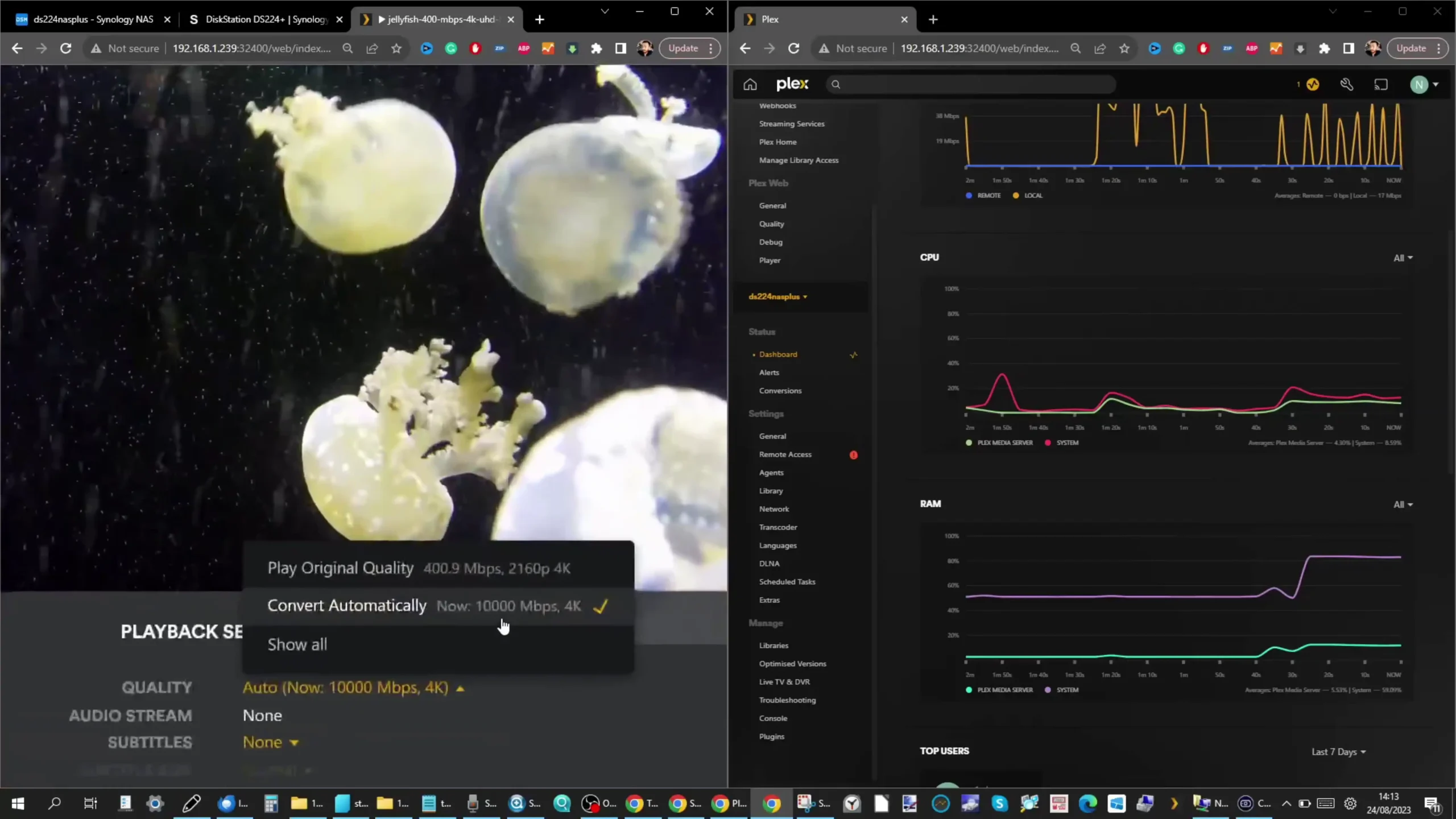
This capability is especially important for homes or small offices that want centralized media storage without relying on local playback compatibility. During testing, the DS225+ performed adequately when transcoding one or two 1080p streams simultaneously, especially when the source files used H.264 or H.265 formats compatible with the GPU.
Synology’s native apps like Surveillance Station and Synology Photos also benefit from integrated graphics, improving responsiveness during thumbnail generation and background indexing of photos and videos. While not intended for intensive media workflows, the DS225+ offers enough GPU performance for common multimedia use cases, making it more versatile than similarly priced NAS units that lack any form of video acceleration.
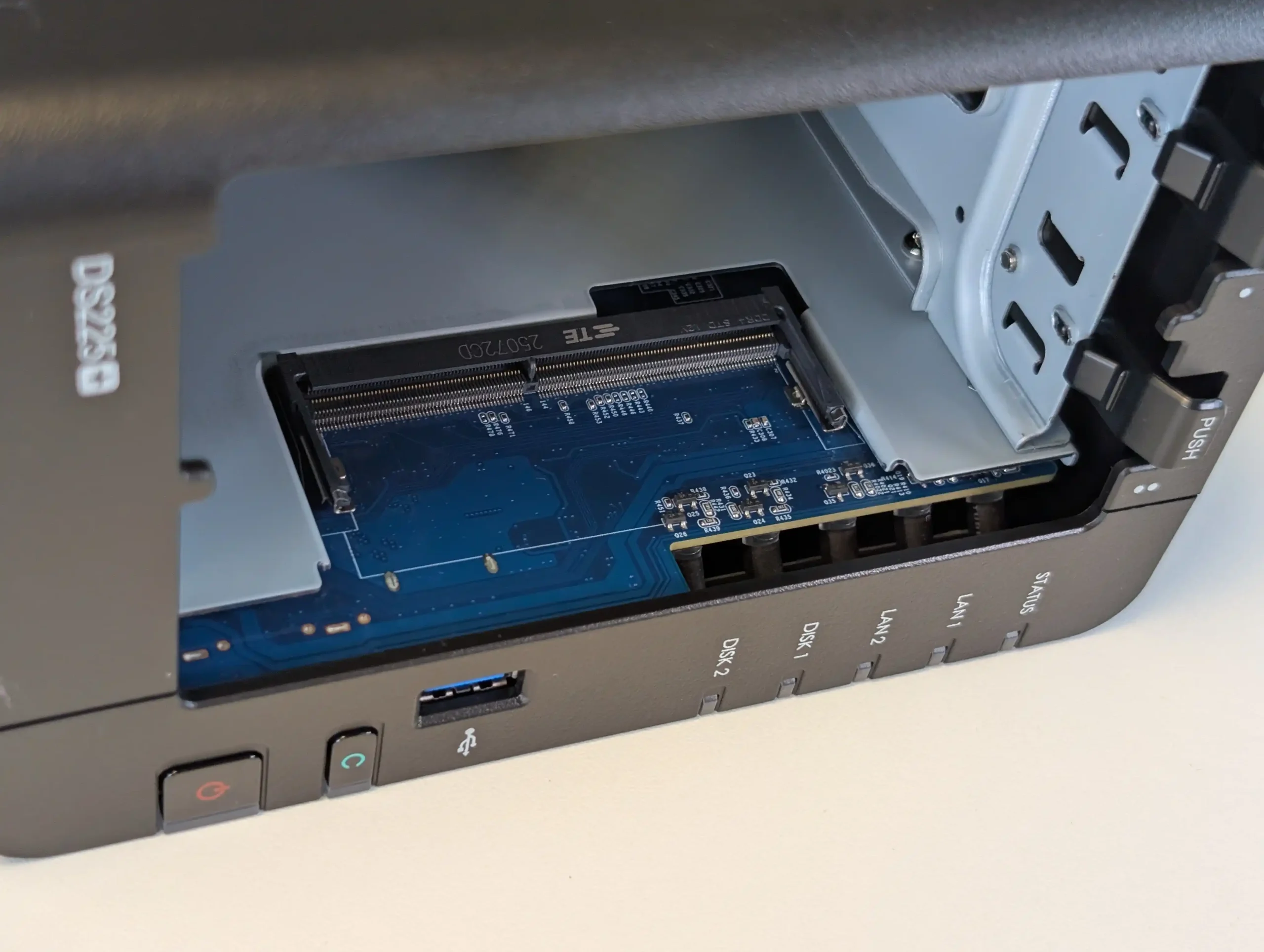
Limited Memory and Restrictive Upgrade Policy
The DS225+ ships with just 2GB of DDR4 memory, which is soldered directly to the motherboard, limiting flexibility from the outset. While it does feature a single accessible SODIMM slot to expand the total memory to 6GB (2GB onboard + 4GB additional), Synology officially supports only their own branded 4GB memory module. Using non-Synology memory will either trigger DSM warnings or void technical support eligibility. This restrictive policy contrasts with other NAS vendors that support industry-standard memory upgrades more openly. In practical terms, the 6GB ceiling is already considered low for 2025, especially as DSM continues to expand its service ecosystem and memory-hungry packages like Photos, Drive, and Surveillance Station become more prevalent.
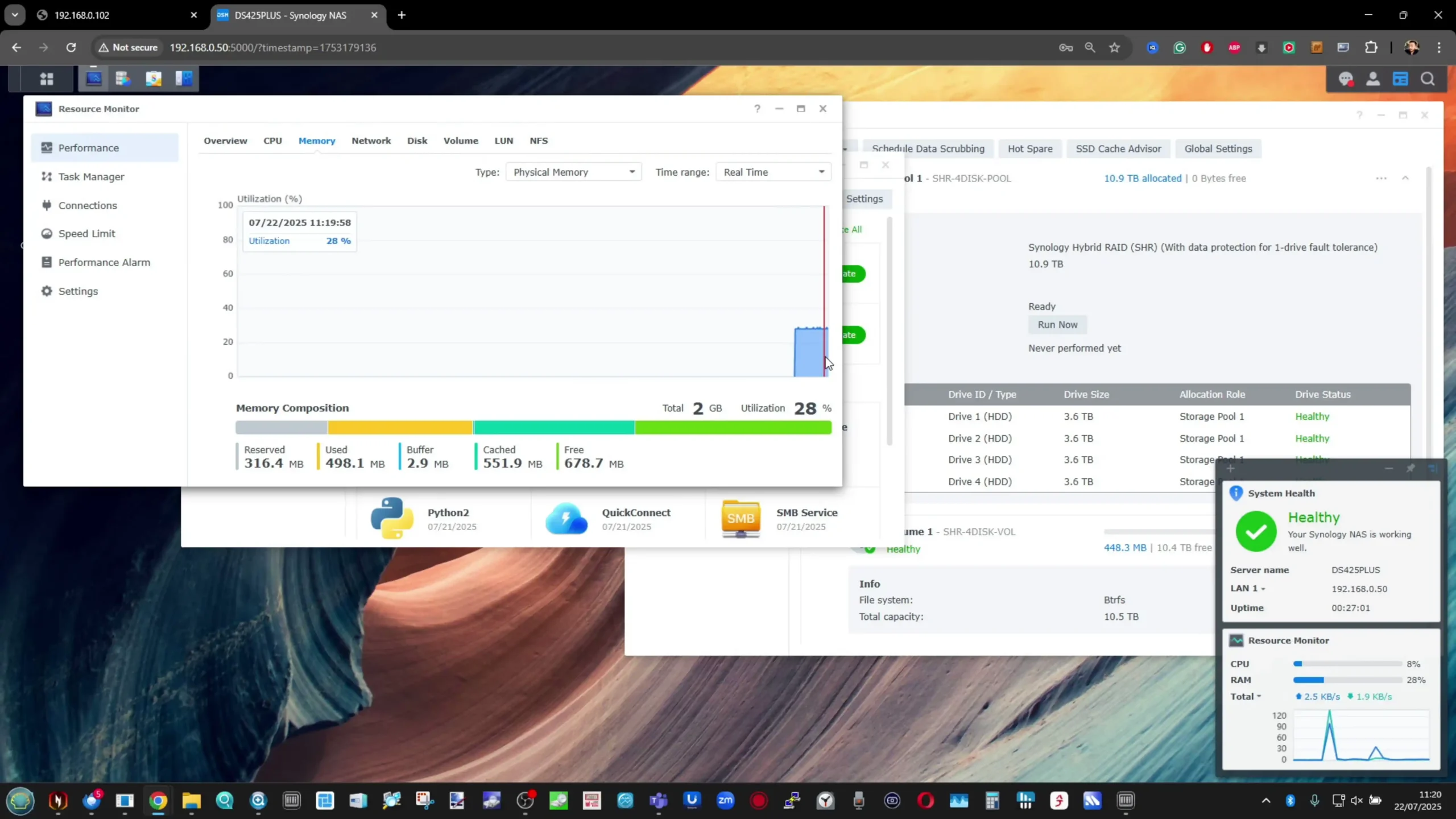
Real-world testing shows that even at idle with no user-installed applications, DSM often consumes 28–38% of available memory due to intelligent caching. Once additional services are installed—such as indexing, media streaming, or light virtual machines—the system can begin to feel constrained, leading to slower response times or increased reliance on swap memory. For example, enabling facial recognition in Synology Photos or running simultaneous Docker containers may quickly push the system beyond its comfortable operational range. This limitation makes the DS225+ poorly suited for users who want to experiment with virtualization, host large collaborative environments, or ensure headroom for future DSM features. Even for modest multi-user environments, the soldered memory and limited upgrade capacity represent a clear technical bottleneck.
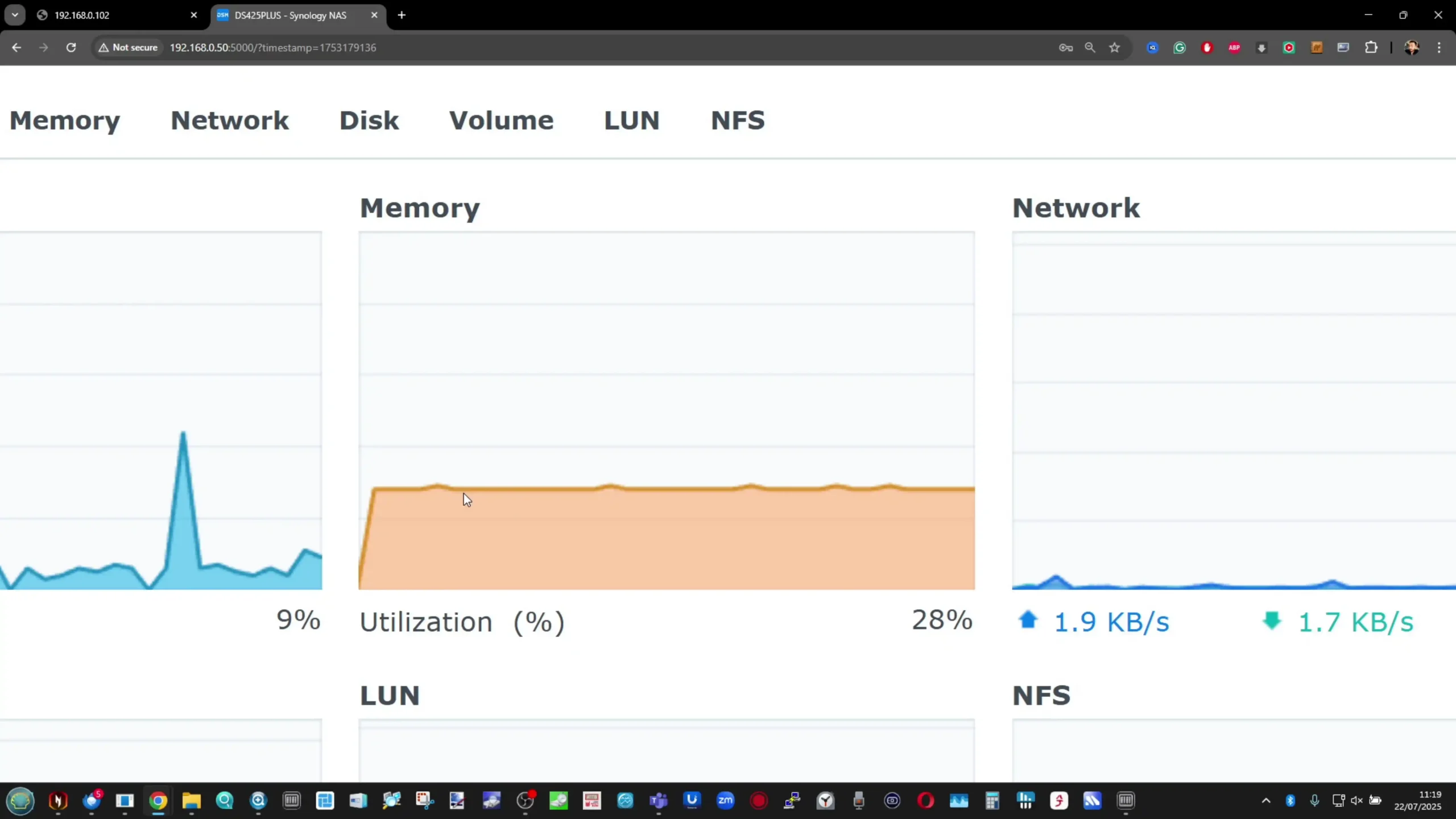
Dual LAN Ports with 2.5GbE Support for Faster Transfers
The DS225+ is equipped with two Ethernet ports—one standard 1GbE and one 2.5GbE—giving users flexibility in how they connect and scale their network performance. This is a meaningful improvement over entry-level NAS models that only offer single Gigabit connectivity, especially as more consumer routers and switches begin to support multi-gigabit speeds. When paired with a compatible switch or direct 2.5GbE connection, the DS225+ can achieve transfer speeds up to 280–290MB/s under optimal conditions, significantly reducing the time needed for backups, media streaming, or large file transfers over LAN. For those sticking to 1GbE setups, the second port still provides redundancy or the option to separate network traffic between general access and administrative tasks.

Although the DS225+ does not support link aggregation or PCIe expansion, having dual LAN ports allows for some segmentation and future-proofing in small network environments. Users can reserve the faster 2.5GbE interface for high-priority devices such as a workstation or editing PC, while the 1GbE port can be used for background syncing, IP camera feeds, or system management. The inclusion of 2.5GbE is also relevant in home lab and prosumer scenarios, where higher-speed NAS-to-NAS replication or remote backup over multi-GbE connections is becoming more common. While the benefit is conditional on the rest of the network infrastructure supporting these speeds, it’s still an advantage that many previous 2-bay NAS models from this brand do not provide.
Limited I/O Expansion and Slower USB Connectivity
While the DS225+ includes the essentials for a basic NAS setup, its external connectivity is minimal, offering just two USB 3.2 Gen 1 ports, each limited to 5Gbps. This is notably behind the current standard of USB 3.2 Gen 2, which offers 10Gbps, and well below newer competitors that feature USB-C, eSATA, or PCIe slots for future expansion.
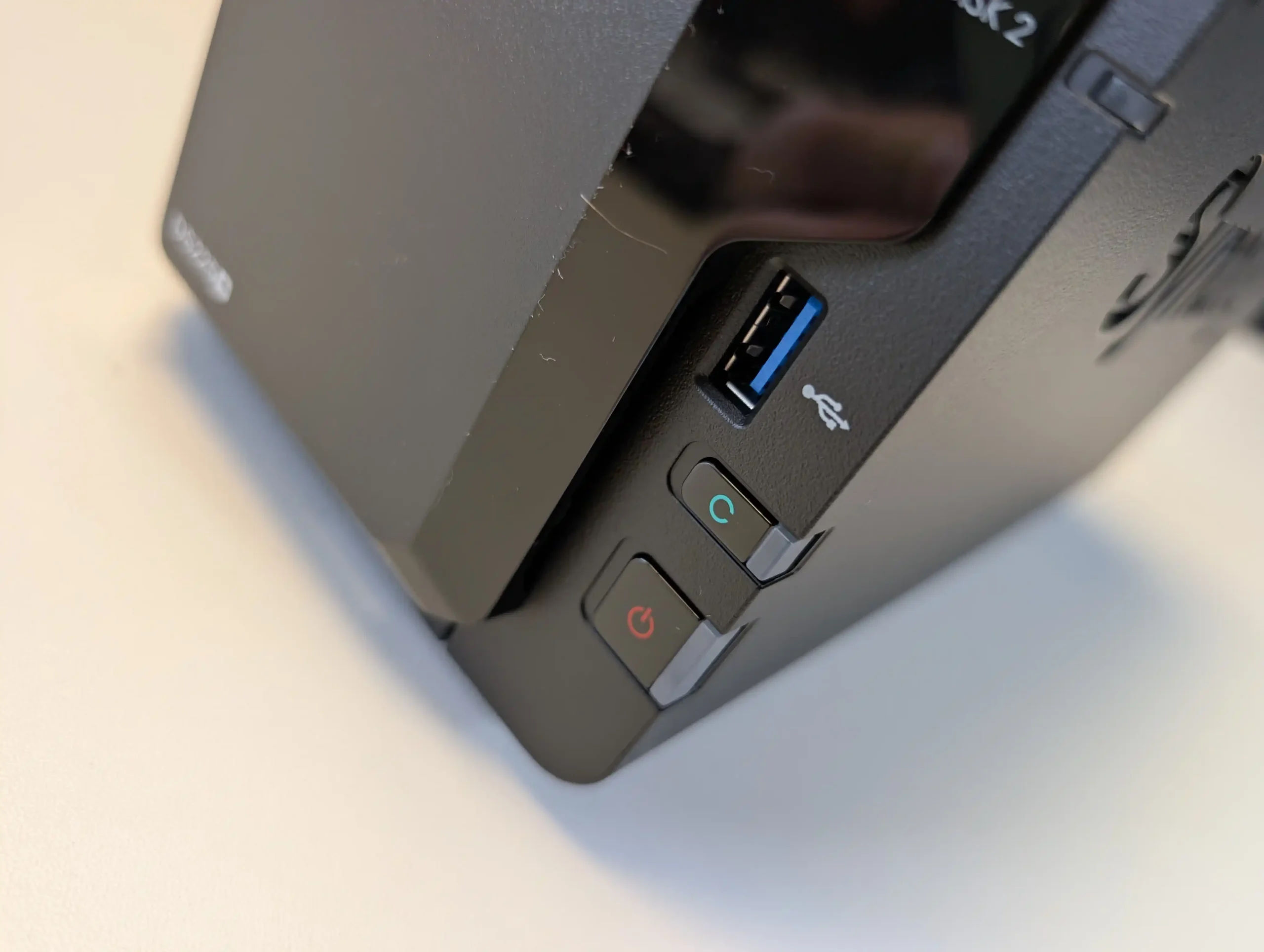
The lack of a front-mounted USB port or SD card reader also reduces convenience for users who regularly transfer media from cameras or external drives. In scenarios involving backup rotation, media ingestion, or hot-swapping data from multiple USB devices, users may find themselves manually unplugging and swapping cables due to the low number and placement of ports.
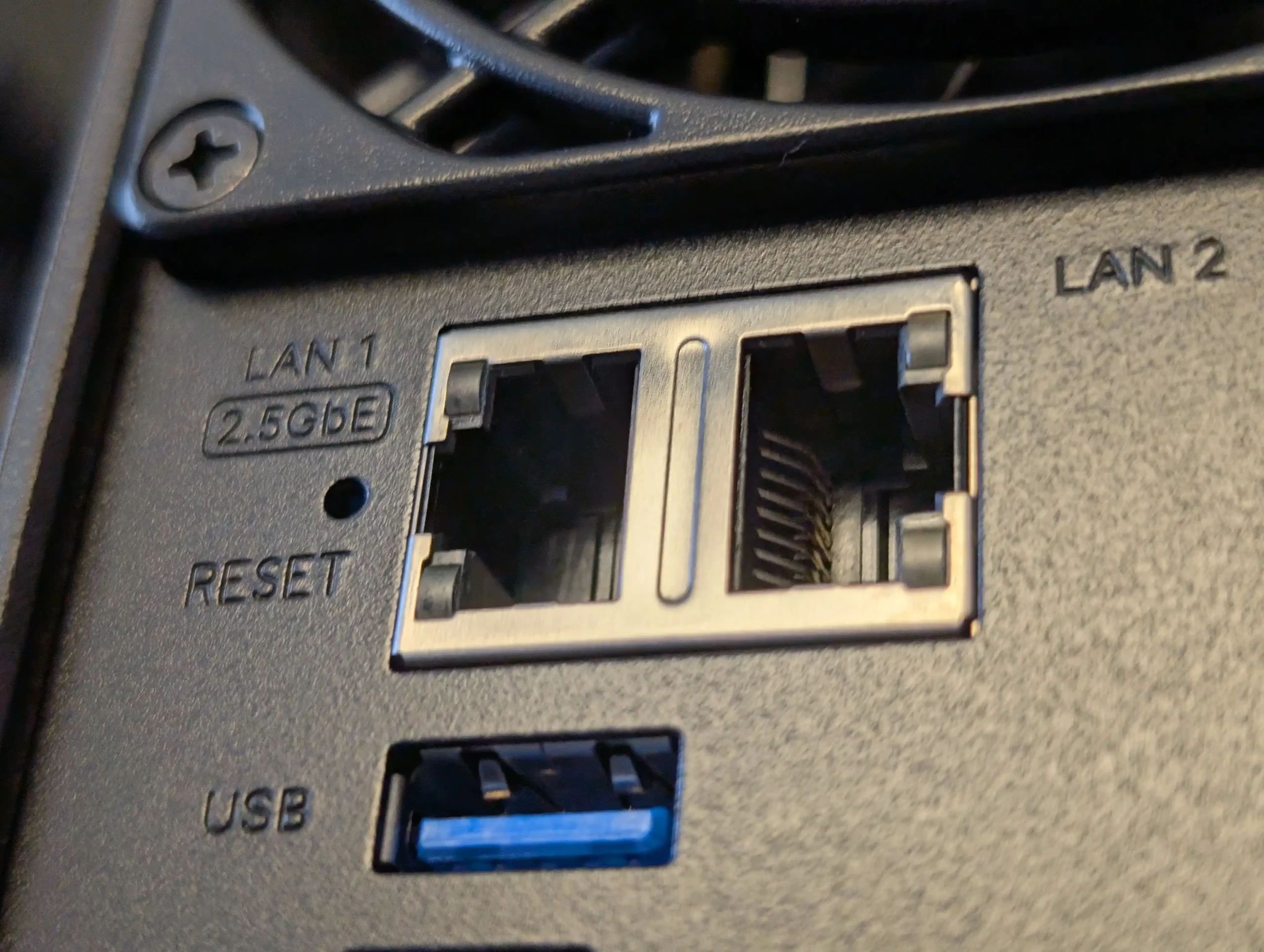
This limitation becomes more pronounced as the DS225+ cannot be expanded via PCIe, ruling out the addition of 10GbE networking, additional NVMe cache, or external SAS enclosures. Even Synology’s own expansion units are unsupported on this model, meaning what you see is essentially what you’re locked into for the lifespan of the system. While the DS225+ works well within its default role, users requiring scalable connectivity for workflows like multi-tiered backup, external archives, or direct media workstations will likely find it too constrained. The inability to expand I/O makes it harder to adapt the device as your setup grows or changes, placing it at a disadvantage in a market where even entry-level NAS units are becoming more modular.
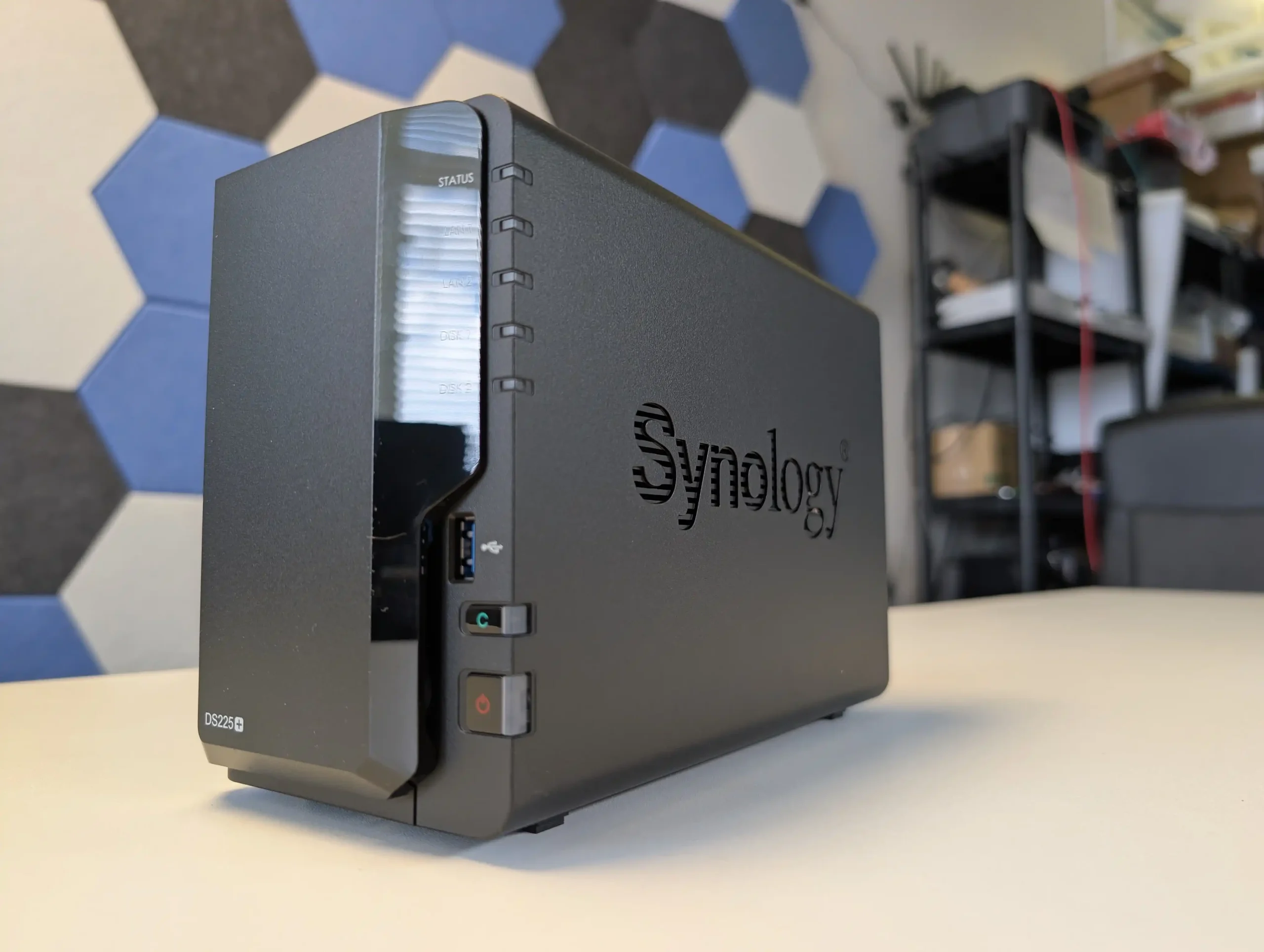
Compact Design with Full DSM Access and RAID Flexibility
Despite its small physical footprint, the DS225+ delivers the full functionality of Synology’s DSM ecosystem, enabling users to configure advanced storage, backup, and collaboration features without needing a larger or more expensive unit. Measuring just 165 mm x 108 mm x 232.2 mm and weighing 1.3 kg, the DS225+ fits easily on a shelf, under a desk, or alongside other AV equipment. This makes it especially appealing to users with limited space or those looking to maintain a minimal setup. The 2-bay form factor supports 3.5″ SATA HDDs or 2.5″ SSDs, and users can configure their storage using Basic, JBOD, RAID 0, RAID 1, or Synology Hybrid RAID (SHR) depending on redundancy and capacity needs.
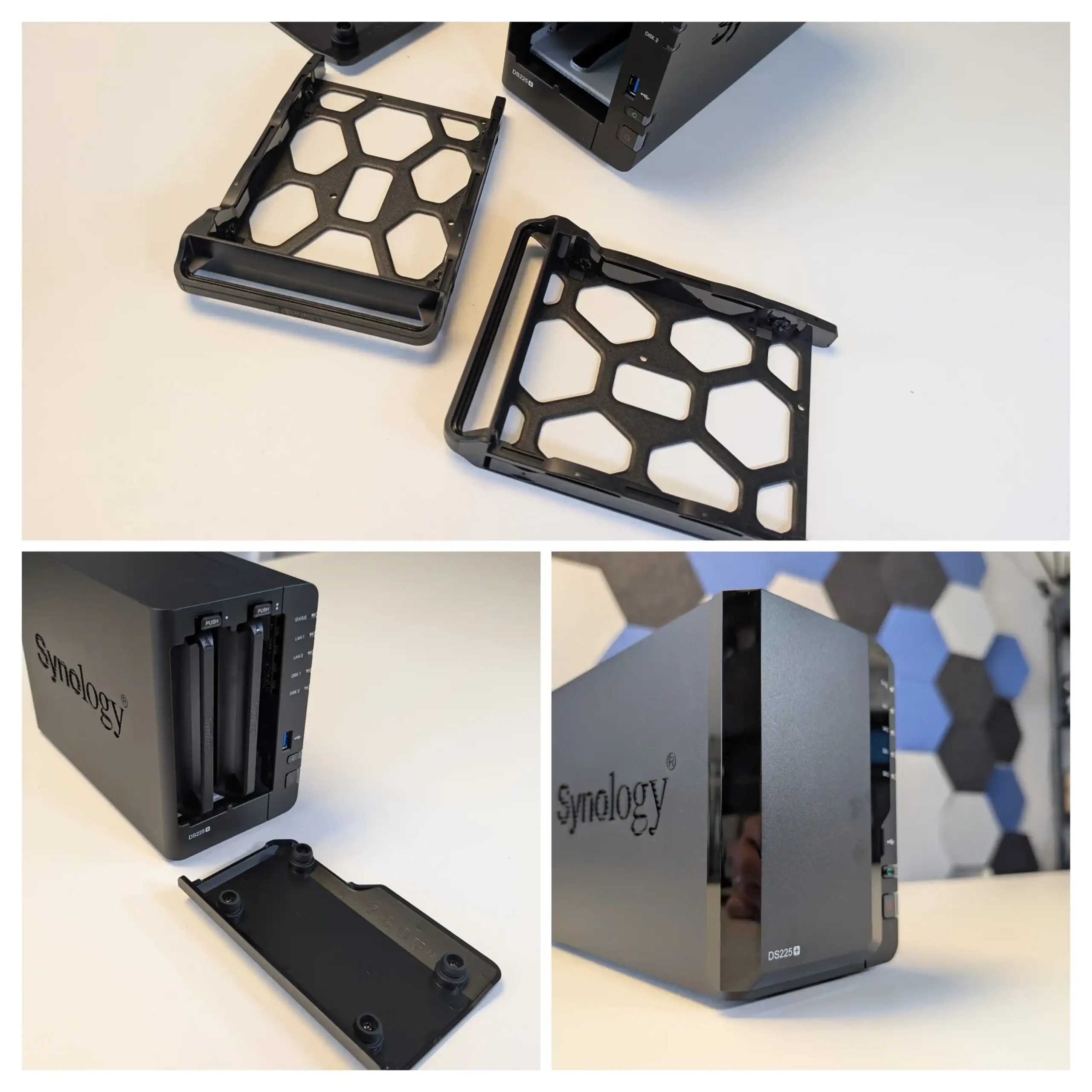
The benefit here is that while the DS225+ lacks the expansion features of higher-end NAS units, it doesn’t compromise on software or configurability. DSM allows for volume expansion with larger drives, RAID migration from Basic to RAID 1, and SSD TRIM support for improving SSD longevity. Users can also benefit from Btrfs snapshots and file versioning, even on this compact system.
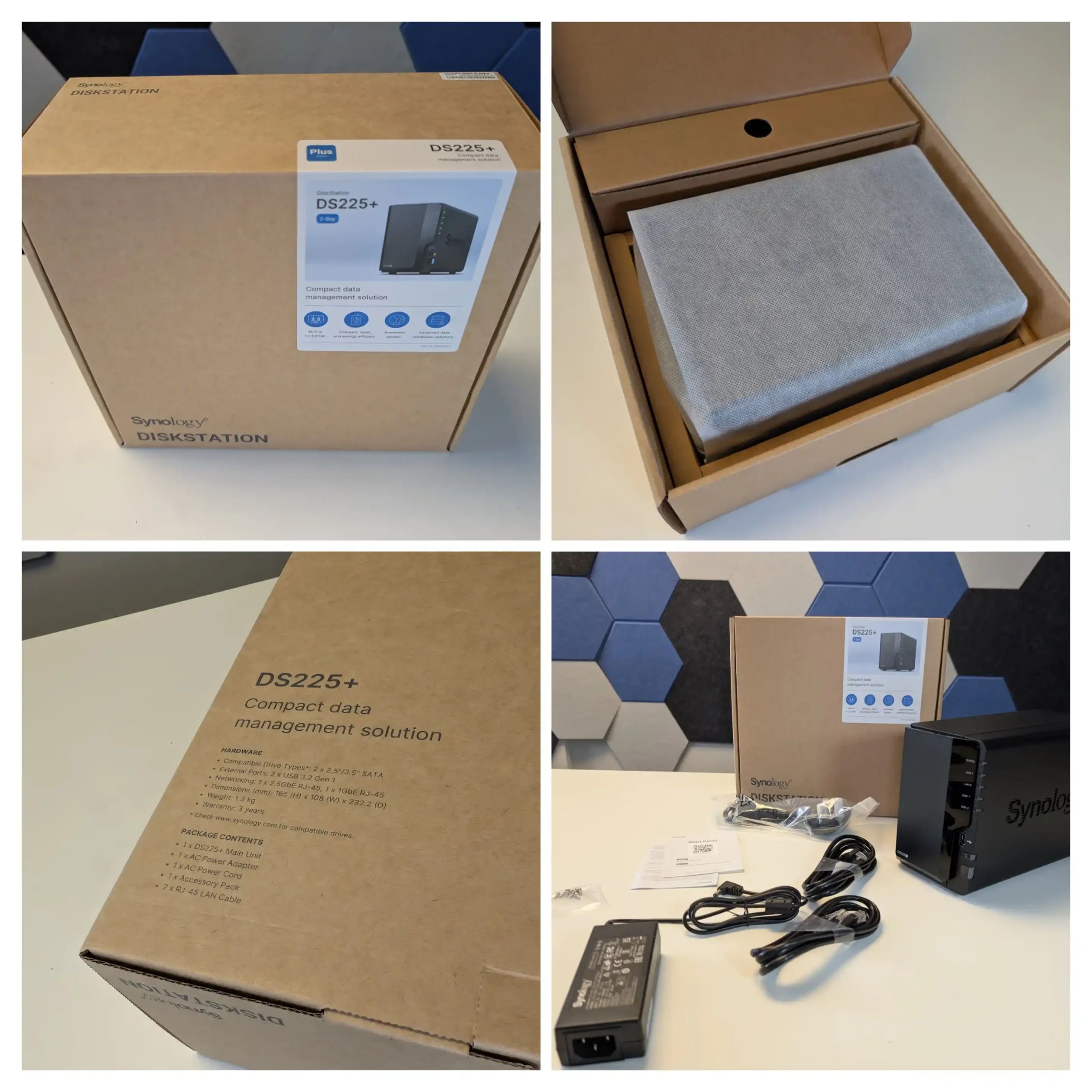
This flexibility allows individuals to start with a single drive and expand or rebuild as storage needs increase. The ability to pair this with external drives via USB 3.2 for backups or offloading archived content extends its functionality further. For users who want the core NAS experience without the complexity or physical scale of larger models, the DS225+ is a strong, space-efficient option.
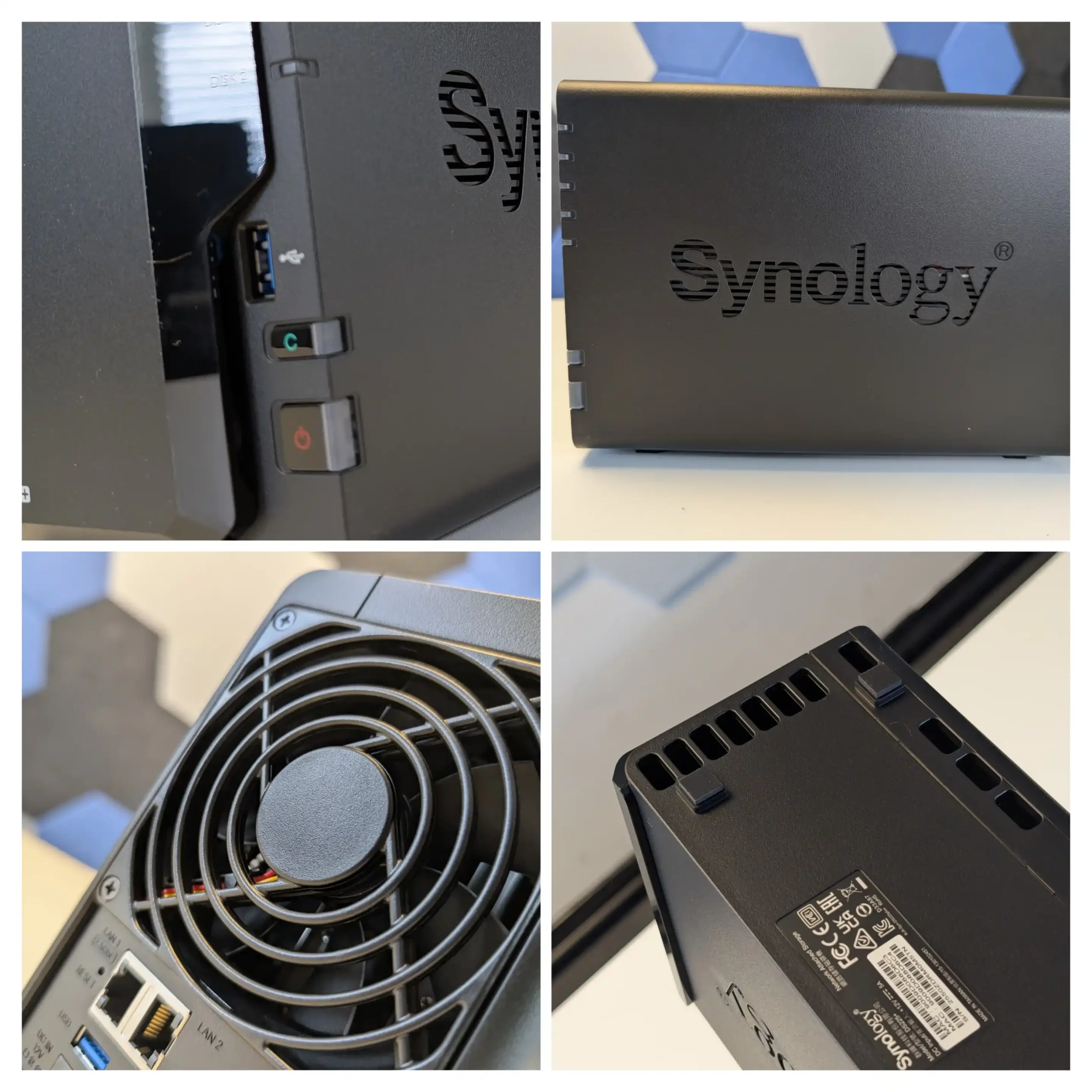
Unclear Upgrade Path Amid Synology’s Strategic Shift
The DS225+ sits within a transitional period for Synology, during which the company has increasingly signaled a shift toward pre-populated, locked-down platforms such as the BeeStation and BeeStation Plus series. These newer lines are aimed at users seeking simplicity and cloud-like convenience, but they also reflect Synology’s broader move toward closed ecosystems with tighter control over hardware and software integration. As these preconfigured models begin to replace traditional bare-metal Plus series NAS options in Synology’s lineup, it’s unclear how much longer models like the DS225+ will remain actively supported or prioritized in DSM development.
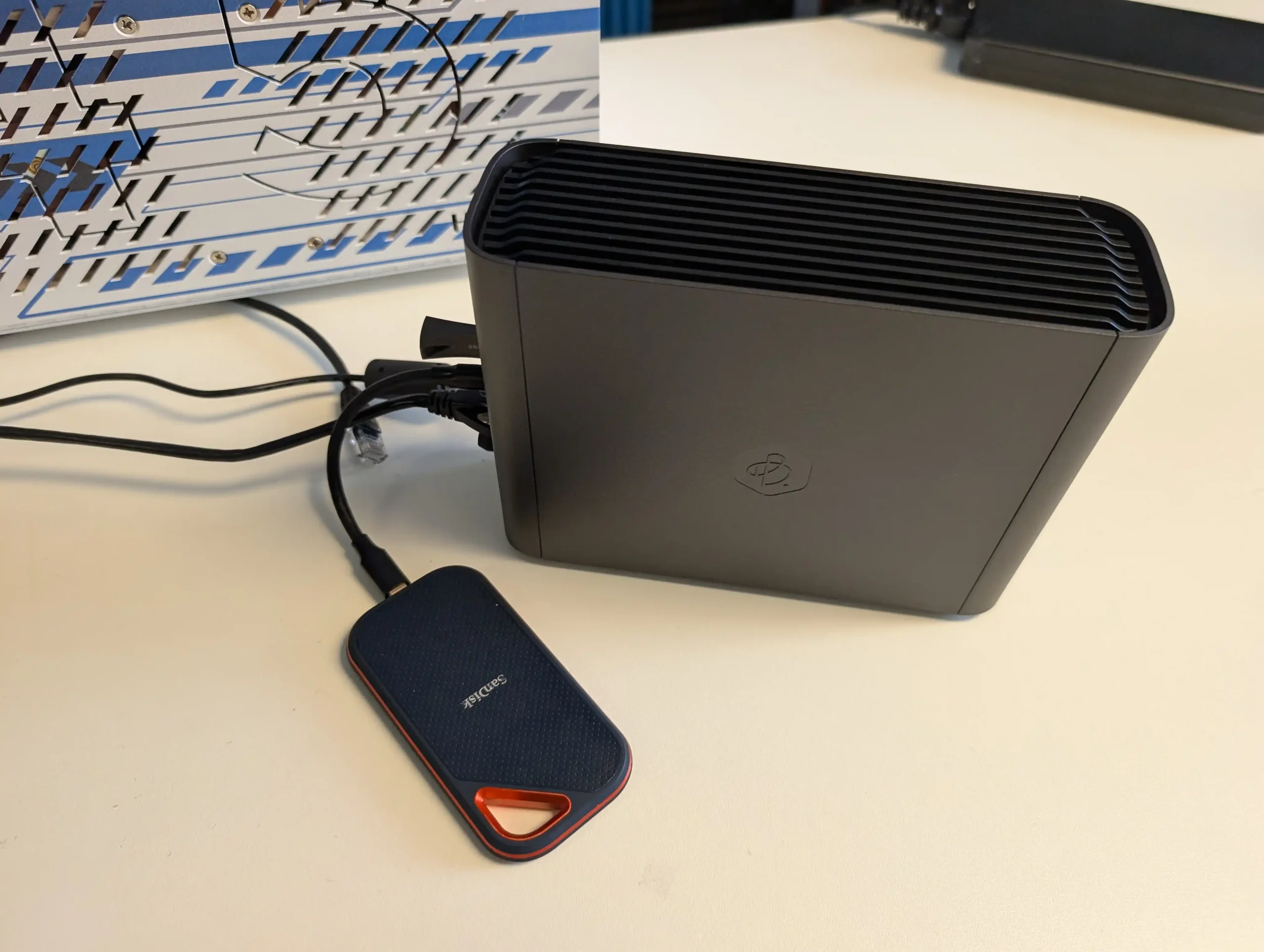
This creates uncertainty for prospective buyers who want a long-term investment. While Synology’s current support lifecycle is generally strong, the tighter coupling between software and specific hardware could eventually result in DSM updates being optimized for newer, more restrictive platforms. For example, users of the DS225+ may find that future DSM features—such as enhanced AI functions or hybrid cloud integrations—are limited or unsupported due to the older CPU or reduced memory ceiling.
Additionally, if the company continues to prioritize its locked-drive strategy and proprietary accessories, even firmware-level changes could make legacy systems like the DS225+ feel increasingly boxed in. This isn’t an immediate concern, but for users thinking 3–5 years ahead, the direction of Synology’s portfolio suggests the DS225+ may not age as gracefully as its predecessors once did.
Synology DS225+ NAS Review – Verdict and Conclusion
The Synology DS225+ delivers a polished and well-integrated NAS experience that caters to home users and small teams looking for dependable data storage, backups, and light multimedia handling. Its compact form factor, efficient thermal and acoustic design, and access to the full DSM 7.2 ecosystem make it a compelling choice for those who prioritize low noise, low power use, and a robust software suite. The inclusion of 2.5GbE networking, integrated graphics for basic Plex or Jellyfin transcoding, and support for Btrfs, SHR, and snapshot replication ensure that it remains practical for a wide range of core NAS tasks. It’s a system that “just works,” and for many users, that is enough to justify its place on their shortlist.
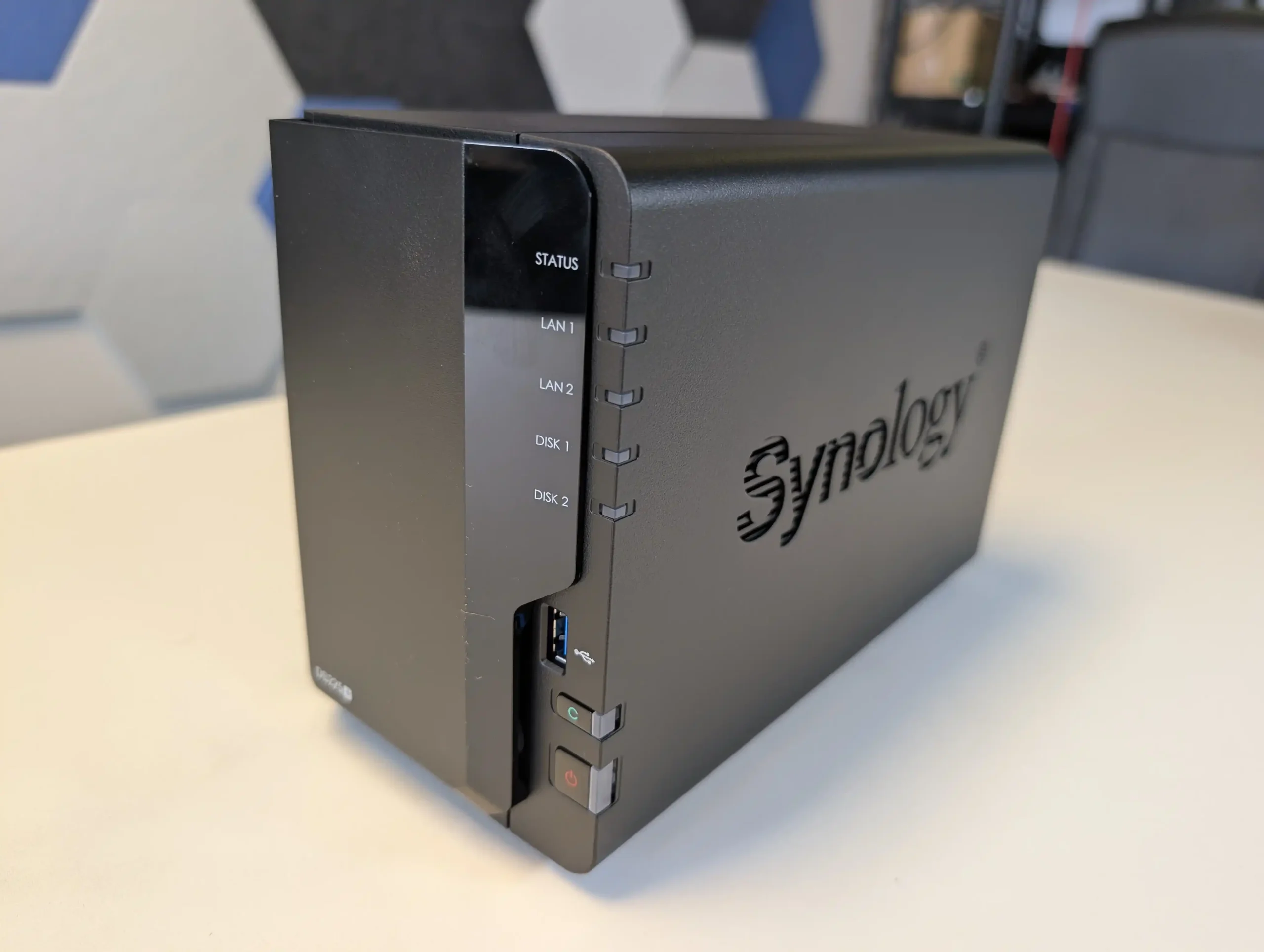
However, the DS225+ is increasingly defined by its limitations as much as its strengths. The use of an aging processor, restricted memory expansion, limited I/O, and locked-down drive compatibility significantly reduce its appeal for users who expect flexibility, performance headroom, or long-term scalability. When positioned against similarly priced or even cheaper NAS solutions from competing brands—many of which offer newer CPUs, broader third-party drive support, and better external connectivity—the DS225+ risks feeling outdated straight out of the box. Synology’s evolving product strategy also casts doubt on the long-term direction for devices like this. For users who are already committed to the Synology ecosystem or need something simple and quiet for basic NAS duties, the DS225+ can still be a solid purchase. For those looking for open-ended expandability or stronger hardware per dollar, however, it’s worth comparing alternatives or waiting to see how Synology’s next generation unfolds.
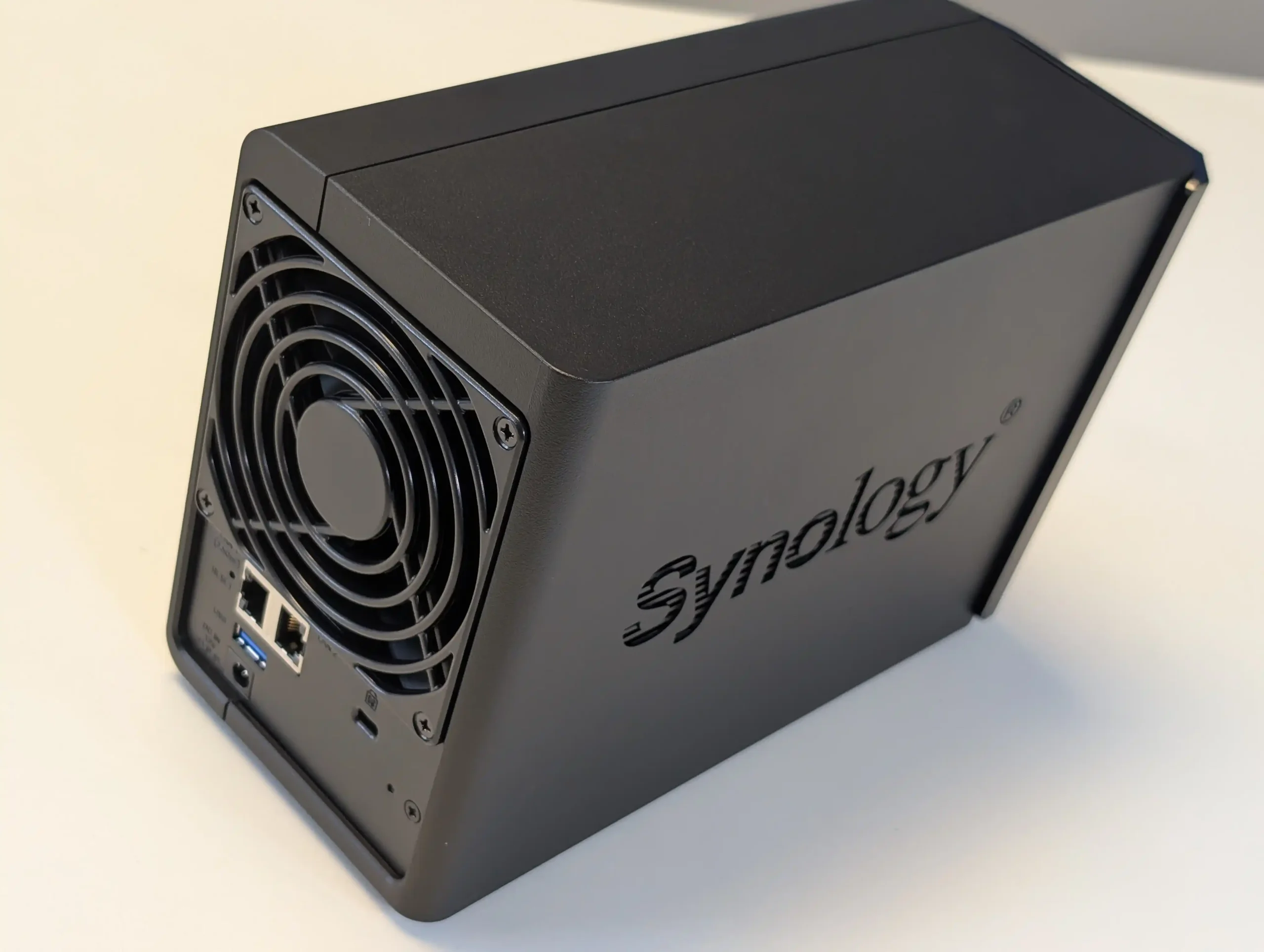
|
Synology DS225+ NAS |
|
|
Amazon in Your Region for the Synology DS225+ NAS @ $339 |
B&H for the Synology DS225+ NAS @ $339.99 |
| Synology DS225+ NAS Pros | Synology DS225+ NAS Cons |
|
|
📧 SUBSCRIBE TO OUR NEWSLETTER 🔔
🔒 Join Inner Circle
Get an alert every time something gets added to this specific article!
This description contains links to Amazon. These links will take you to some of the products mentioned in today's content. As an Amazon Associate, I earn from qualifying purchases. Visit the NASCompares Deal Finder to find the best place to buy this device in your region, based on Service, Support and Reputation - Just Search for your NAS Drive in the Box Below
Need Advice on Data Storage from an Expert?
Finally, for free advice about your setup, just leave a message in the comments below here at NASCompares.com and we will get back to you. Need Help?
Where possible (and where appropriate) please provide as much information about your requirements, as then I can arrange the best answer and solution to your needs. Do not worry about your e-mail address being required, it will NOT be used in a mailing list and will NOT be used in any way other than to respond to your enquiry.
Need Help?
Where possible (and where appropriate) please provide as much information about your requirements, as then I can arrange the best answer and solution to your needs. Do not worry about your e-mail address being required, it will NOT be used in a mailing list and will NOT be used in any way other than to respond to your enquiry.

|
 |
A Buyer's Guide to Travel Routers - GET IT RIGHT, FIRST TIME
Jonsbo N6 DIY NAS Case Review
The Best Bits (and Worst Bits) of NAS of 2025!
Minisforum MS-02 Ultra Review
Minisforum N5 NAS, 6 Months Later - Better, Worse, the Same?
Beelink ME Pro NAS Revealed
Access content via Patreon or KO-FI
Discover more from NAS Compares
Subscribe to get the latest posts sent to your email.


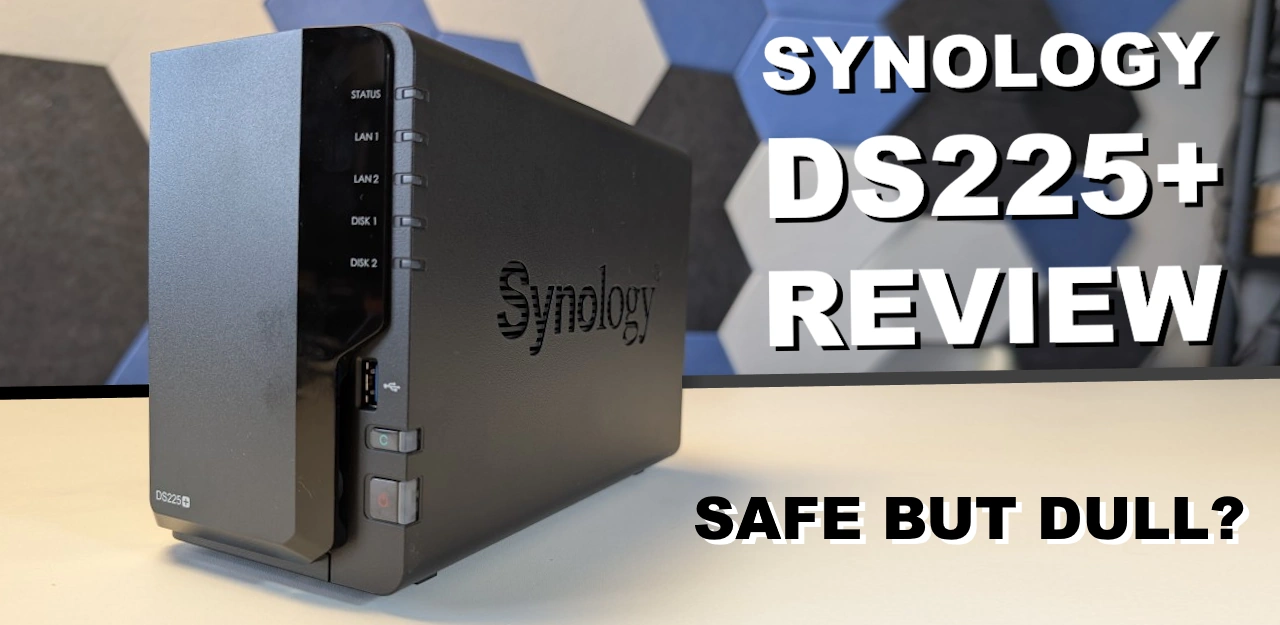


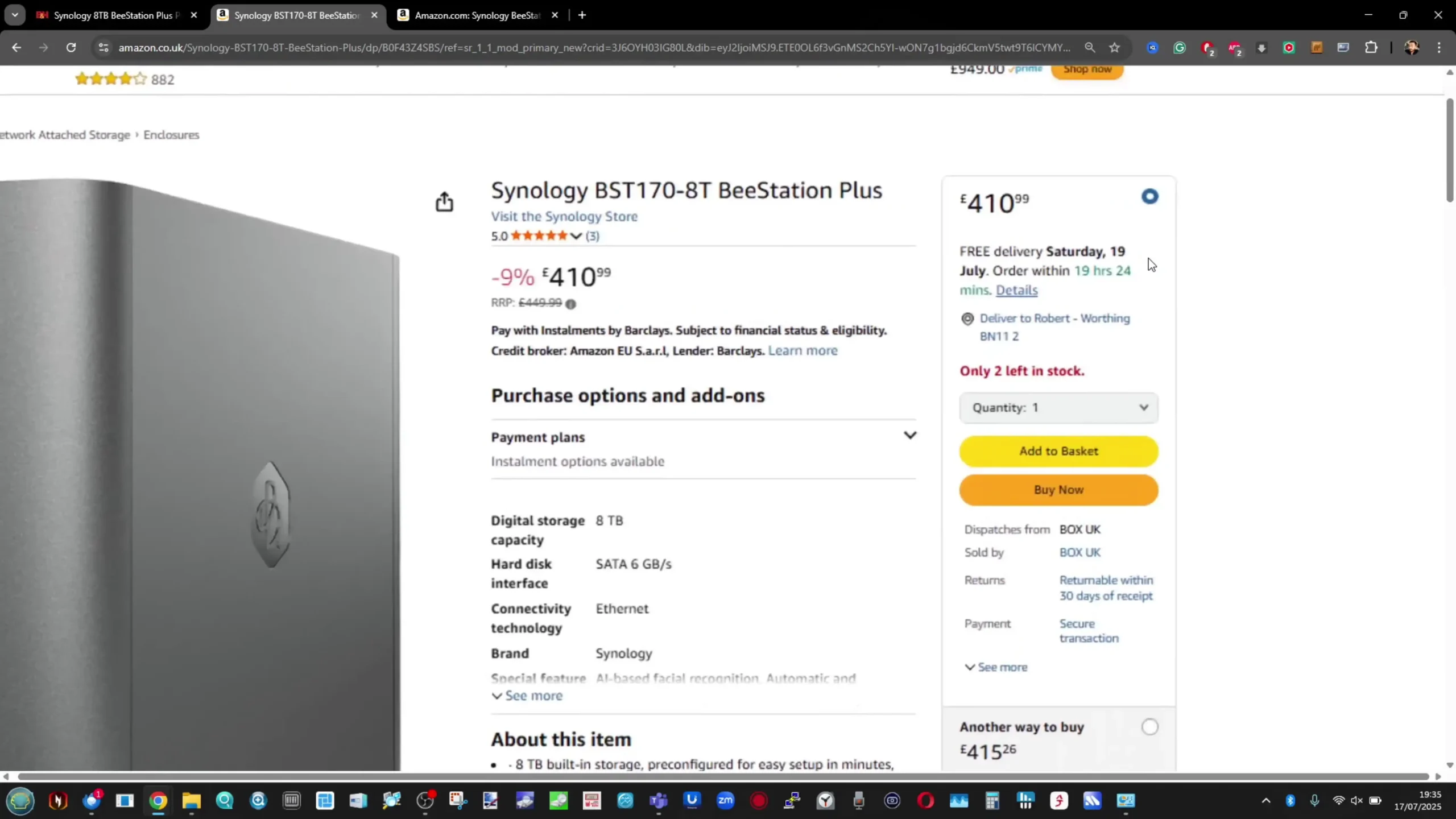



Haven’t considered this but Im being pulled in. I basically want a basic Plex server as I have plex pass and a Time Machine destination. My question can it be a Time Machine destination. Im a Mac household.
Im currently using a WD my cloud for Time Machine and it’s sloooooow
REPLY ON YOUTUBE
The No Third Party Drives is the reason I wil abandon these
REPLY ON YOUTUBE
But doesn’t beestation to be terrible in streaming videos?
REPLY ON YOUTUBE
Hi Mate, I’ve been watching your videos for years now, excellent information! ????????????.
My Synology 918+, with 4 seagate ironwolf4TB each, just died on me ????
I had an electricity issue. My Synology should have been protected as it was plugged into my APC UPS and connected via the RJ 50 powershute cable… it should have shut down properly, as already happened. Furthermore the UPC is supposed to protect against surges ???? so I don’t understand what’s wrong.
As I was not sure if the external alim worked (no blue light), I ordered a new one… this new alim works… but my Syno is still “dead”, no blue light at all, and I’m not confident enough to try to check the BIOS or try to repair the motherboard… (I did some research…)
My Syno with all my life in it is tranformed into a brick ????gone, ceased to exist after 5 year of good work.
Do you reckon I can buy this DS425+ NAS, install my 4 hard drives in the right order in it… and it will work?
or is it just bad luck for me?
Or perhaps there are comptent people you know around the South East to repair this properly???
Hope you can help.
Thanks anyway ???? and keep up the great job
????
PS I’m thinking of moving yto another brand now ???? (hard drive compatibility…)
REPLY ON YOUTUBE
The good thing about Beestation is having privacy; the admin in no way could see the photo gallery of other users that has been uploaded. In a typical synology DSM, the admin has access to the users’ files, unless the access was switched off.
REPLY ON YOUTUBE
I have a DS215J. Still going strong. I’d like to upgrade it to take advantage of some of the new features DSM has to offer. I mean, it’s been a while! Planned on moving my old hard drives from the DS215J to the new NAS. Because I don’t need new hard drives, and buying one with hard drives puts it out of my price range. With that said, I’ll just deal with it and keep the trusty DS215J..
REPLY ON YOUTUBE
Looks like we are skipping Synology.
REPLY ON YOUTUBE
Due to recent decisions, I’ll stick with my trusty DS 720+ ????
REPLY ON YOUTUBE
what is next? branded electricity from Synology?
REPLY ON YOUTUBE
Can we have multiple users and Can we create private and password protected folder for each user?
REPLY ON YOUTUBE
Single drive with only 1Gbit network is sufficiant. Drive speed is high enough to push data onto network.
REPLY ON YOUTUBE
Two NAS models for home use that perfectly fulfill their purpose. A DSM operating system that’s unmatched for anyone who isn’t a professional or expert. I’ve had my NAS with two 4TB SSDs Samsung and 8GB of Crucial RAM for four years now, using it heavily, and I’m very happy with it.
REPLY ON YOUTUBE
I have TWO Macs I would like to backup with Time Machine on my new Bee Station Plus. It’s all set up and ready to go. Can I backup both Macs without setting quotas or separate user log ins for each one in Bee Station? The Bee limits to 4 TB for the Time Machine folder already and I would prefer to just set the quotas in Time Machine (or not). I only have 1.5 TB between both Hard Macs.. Just want to keep it as simple as possible. Thanks!
REPLY ON YOUTUBE
I have TWO Macs I would like to backup with Time Machine on my new Bee Station Plus. It’s all set up and ready to go. Can I backup both Macs without setting quotas or separate user log ins for each one in Bee Station? The Bee limits to 4 TB for the Time Machine folder already and I would prefer to just set the quotas in Time Machine (or not). I only have 1.5 TB between both Hard Macs.. Just want to keep it as simple as possible. Thanks!
REPLY ON YOUTUBE
Can you show how I can use google photos takeout maintaining metadata and save the files to beestation. I know there is a way but I would like to see an example for multiple users. I know you can’t see the guest profiles data so how can I upload their files? Thanks
REPLY ON YOUTUBE
Not until there are two drives
REPLY ON YOUTUBE
synology is the best turnkey but DAMN are they trying to rape everone
REPLY ON YOUTUBE
My DS218+ is getting long in the tooth. A DS225+ seems like it *ought to be* the obvious replacement. But in many, maybe most, ways it hardly seems like an improvement on the EIGHT YEAR OLD DS218+. Only the slightest possible CPU upgrade. No more base memory. Can’t add 3rd-party 4GB now and still the exact same 6GB total. Yes, it adds a 2nd, and 2.5GB, Ethernet. But it has one fewer USB–that’s a real problem to me as I use one of the DS218+ rear ports for UPS and the second for a full-time 5TB portable for Hyper Backup. The new one gives up hardware transcoding completely. And, as noted in the video, it’s really hard to sense that Synology has their heart in the Plus series products anymore. And whether Synology might, say, drop support for third party HDDs on, say, DSM 8, now seems like a real possibility. Sad.
REPLY ON YOUTUBE
does the same go for ram, like hd. By Synology no more encoding on this old processor and ugreen is out since usa might turn off at any time china bs like tp link routers is on thin ice
REPLY ON YOUTUBE
Got it. Dont buy this SHIT. Low specs, pricey, and the headshot with HDDs . Fuk that. I m sticking with my DS224+ for now .
REPLY ON YOUTUBE
I have a DS 415 play and it is still working. Even though it is deprecated for some years now. It still gets security updates for DSM 7.11 but it is painfuly slow. Is it possible to migrate the HDDs into lets say a 425+ or a 925+ even though the HDDs are not Synology Branded? I would like to upgrade but not to be forced to purchase 4 new HDDs and then have 4 HDDs unused.
REPLY ON YOUTUBE
so goodbye to Synology, i guess.
REPLY ON YOUTUBE
Definite “Don’t Buy”, as they are still on kernel 4.4. Synology is back where QNAP was 3 years ago, with a now unsupported kernel leaving a broader attack surface. Credit to QNAP where credit is due, they seem to have been doing a good job on security in many areas. I expect them to move to kernel 6.12 next year, to maintain their security posture.
REPLY ON YOUTUBE
If it had 2,5gbit port I would actually considering to buy this
REPLY ON YOUTUBE
Still have not found anything as good as my drobo 5n which has gone bust but my drive still runs100%. Wish they’d make a comeback
REPLY ON YOUTUBE
Still have not found anything as good as my drobo 5n which has gone bust but my drive still runs100%. Wish they’d make a comeback
REPLY ON YOUTUBE
Still have not found anything as good as my drobo 5n which has gone bust but my drive still runs100%. Wish they’d make a comeback
REPLY ON YOUTUBE
Its a high no.
REPLY ON YOUTUBE
Newbie here.
Thanks for posting. I’m one of the totally uneducated when it comes to NAS and having literally just returned a BeeStation 4TB to Synology because it spent WAY more time being ‘busy’ sorting out thumbnails, indexing, etc. than actually accessible whilst handling small uploads of less than 100 images at a time (I’m talking hours here, not just minutes), I was curious to see if this 8TB model maybe overcame the 4TB’s shortcomings.
I think you’ve convinced me the answer is most likely NO.
I’m not looking for anything wildly sophisticated, just a wi-fi and internet attached storage on which I can maintain and readily access my photograph and home video collection within a tiered directory structure (BeePhotos only offers a single directory structure, so I was obliged to use BeeFiles) without hauling a DAS around.
It sounds like a 2-bay is the logical baseline (a 4-bay would be nicer, but harder to justify on a pension), although not so sure yet what a minimum CPU/storage configuration would get me past the ‘busy’ problem I encountered with the BeeStation 4TB.
I did see plenty of recommendations for an Asustor AS5402T, but I think this is way more than I need as a humble septuagenarian living out retirement.
Any advice gratefully received.
TIA
REPLY ON YOUTUBE
FYI for anyone thinking of purchasing a 225 or 425 for plex, Synology have purposfully disabled the iGPU, so these units are no longer capible of HW Transcoding.
“As part of our roadmap, starting with products released in 2025 and beyond, even if the CPU supports hardware transcoding, we will no longer provide the driver required to enable it. An exception is the BeeStation Plus, where we specifically obtained the appropriate licenses and paid the required fees, which is why hardware transcoding is available on that model.
We hope this explanation helps you gain a clearer understanding of the situation, and we sincerely appreciate your feedback, as it helps us better address the concerns of our users.
Best Regards,
Technical Support
Dino Hsu”
REPLY ON YOUTUBE
Bought the ds224+ a few months ago. For the generic Joe like me it’s more than you ever need. Set up plex, my own cloud for files, synology photos that syncs right away from anywhere, and hyper backup to an offside nas. Couldn’t be happier.
REPLY ON YOUTUBE
Depends on the use case. IT hardware is just a tool to solve a problem or fill a need. Hobbyists want to do it all because they can and use all the old hard drives they have lying around. Synology have put these devices into the business class and said “we will only offer support if you use supported drives”, for now Synology branded drives. A diversion that explains in a similar context. A mechanic repaired a car with user supplied parts, one of which failed shortly after installation. No warranty for that guy and the mechanic declared that was the last time he would fit user supplied parts. That’s the reason for the Synology supplied drives situation. Business use demands reliability. For home while it would be awesome to do whatever you want, plus devices are not what you want any more. For business which has a single use case, these devices serve a purpose and having warranted drives makes them fit for purpose. Everyone else should just buy ugreen and stop whining. I think that’s a way better choice for the NAS hobbyist.
A further observation, the DS925+ with native 2.5GbE networking goes just fine as a file server for imaging workstations which is my single use case. Setup right it will just about hit 2.5GbE network capacity and there’s no point going faster than that. I’m loving it and I’ll keep it until either the hardware fails or it runs out of software support. It’s replaced an RS815 which is still going fine, however the DS925+ goes way better. I’m not trying to run it as a server for docker, plex or any of the other things folks do but I did stick a lot of memory in it to deal with hundreds of thousands of image files. It will find and use more than the 4G specified for the empty slot, just saying.
REPLY ON YOUTUBE
Thanks for the video as a home user i have moved to Ugreen NAS no drive lockin and has its own video app photos app and an easier to use back up and sync app.
REPLY ON YOUTUBE
Is anyone running a 16gb module and does it work?
REPLY ON YOUTUBE
Synology – unless they change their philosophy of “vendor lock in” for components, buying their product is like a vice on your b@lls. It’s not the $$, it’s the fact that this is DATA, which is usually worth a lot more than the hardware it sits on. I demand maximum flexibility to repair, swap, change components.
REPLY ON YOUTUBE
Single drive, slow bandwith, pricey hardware what do you want us to do with that ?
REPLY ON YOUTUBE
8tb of hdd to me is what 16gb of ram is to professional video editors.
REPLY ON YOUTUBE
THEY LICKED A THUNDER? – STAY AWAY FROM SYNOLOGY – NO MORE TRUST!
Customer for 17 years and without any communication functionality in apps is broken now for months.
We understand now too why posting any comments under their videos on YouTube is disabled – No, we don’t!
If funtionality in apps is broken for months now – what about the security?
Stay away, once a great product. Now crippled. No customer service. No communication.
Stop buying Synology, it hurts to say this after all those happy years.
How can Synology offer a single disc bay product? Headache.
Who is responsible for these decisions?!
Why are longterm customers tortured by these new decision and simply ignored?!
REPLY ON YOUTUBE
There are some practical problems with ‘who it’s for.’ People going cheap and choosing to forgo cloud options aren’t going to pay ‘rent’ to back it up to the cloud longterm. Beginners may not understand how important backing it up is. Buying this, and a separate external 8-terabyte HDD to back it up to, means it’s not quite as cheap as it looked, and not as minimalist as a 2-bay NAS with a pair of 8 TB HDDs in Raid 1 configuration. Since it has no inherent redundancy (cloud subscription doesn’t count!), for comparing to other NAS products, keep in mind that external 8TB HDD for backup, unless you have another NAS you can back this one up to.
REPLY ON YOUTUBE
Thanks.
REPLY ON YOUTUBE
Even if you stick with Synology, their DS223 2-bay offering at around £249 + HDD(s) of your choice, is a far better proposition. If you’re even considering a B Station, you must have some clue about what you’re trying to achieve, and so I see this option making little sense to pretty much anyone.
and YES, their dogged use of 1 Gb Ethernet is baffling when it will bottleneck the installed HDD.
In short, I am finding it difficult to see where the market is for this at its price-point and lack of storage expansion.
REPLY ON YOUTUBE
Guys plz help.. Synology DS225+? or UGREEN NASync DXP2800? I’m totally lost.. I like Syn. Any opinion is helpful………… ????????
REPLY ON YOUTUBE
Only one drive? nope, won’t even recommend.
REPLY ON YOUTUBE
I’m generally interested in these Beestation NAS boxes but I was really hoping this would have been closer to $300. Hell I would take one of these if they gave the option of swapping the HDD and/or if it was a two bay. I don’t have heavy needs and it has to be easy for my family to use but I don’t want to get somethingthat feels like it’ll be obsolete right away
REPLY ON YOUTUBE
400+ knickers for a single drive NAS?
As the late Robin Williams would have said: “F@CK NOOOO!”
REPLY ON YOUTUBE
Cheers Robbie. Helpful. I am toying with either a 425+ or a 925+. My needs are nominal. Time Machine, network drive, cloud drive backup, occasional plex use and backup my singular google workspace account. One thing I hate is slow speeds! Am on a virgin broadband with a 2,5gb port on the router……
REPLY ON YOUTUBE
8tb is joke
REPLY ON YOUTUBE
Beelink already took the Bee name
REPLY ON YOUTUBE
My only question: Can I replace the hard drive when it fails or is this another vendor lock-in model?
REPLY ON YOUTUBE
NAS marketing has come full circle, aggressively promoting an online storage service with the purchase of a 1-bay NAS, which it must be said is not suitable for any purpose. Also, 410 usd, holy macaroni ????
REPLY ON YOUTUBE
Honestly think this is a fantastic idea. I know most people don’t agree but having an accessible NAS to the average person is a fantastic idea
REPLY ON YOUTUBE
WD has been operating in this space for years. My first NAS that I just simply used to store my files and to be able to access them remotely was WD. It was easy to setup and met my needs. It was reliable and never let me down. I replaced it with a Qnap NAS. Porting the data over to the Qnap was easy no restrictions like Synology.
REPLY ON YOUTUBE
I don’t see the point of spending money on a single bay NAS. At that point, you might as well just buy a USB external HDD enclosure, stick a drive in it, and plug it in to a USB port on your router.
REPLY ON YOUTUBE
Software will save synology for now. But I bet they will reverse the big error they made with the vendor lockin. Just bought a Ugreen 8800 plus. Now to figure out unraid or truenas… my current synology up for sale.
REPLY ON YOUTUBE
Locking their system into a propriety backup solution.. yeah that’s going to work considering the amnount of NAS HDD/SDD available.
REPLY ON YOUTUBE
Didn’t really understand if this an be backed up to a Ugreen nas ?????
REPLY ON YOUTUBE
The fan is a bummer. My current made-up Raspberry Pi 4 NAS has no fan, disks spun down when not used: total silence in our office room 90% of the time (this is a backup NAS).
REPLY ON YOUTUBE
No thanks , for my parents it’s easy : iMac , iCloud family with me, AnyDesk and Tailscale so that everything is sync to my nas lol. Even with a Mac, I support my parents at least once a week including updating their iPhones lol
REPLY ON YOUTUBE
No
REPLY ON YOUTUBE
Future bookshelves. Going digital… ????????♂️
REPLY ON YOUTUBE
The capital word EASIEST should be “EASIEST”
REPLY ON YOUTUBE
Wd mycloud ex2 ultra. Aside from the name just better. Got it without drives for 100€
REPLY ON YOUTUBE
410+ for a single bay “nas”? Yeah nah.
REPLY ON YOUTUBE
Shitology
REPLY ON YOUTUBE
400 with 8TB… thats DOA
REPLY ON YOUTUBE
No, thanks. What on earth, Synology?
REPLY ON YOUTUBE
Shame about all the negative attitudes expressed here, none of which seem to be backed up by examples of actual problems or bad experiences. I’ve owned the 4TB BeeStation for exactly a year now and am absolutely satisfied with it:
Savings.Total cost GBP £200 direct from Synology UK (using a -£20 offer, available at the time). Paying for Apple’s iCloud services for just half that amount of storage would have already have cost me £108.
The cheapest dual bay NAS boxes already cost £200+, and still have to be populated with two of these 4TB HDDs. And I would have wanted a redundant system, so my total available storage would be no greater.
Security. I’m not paranoid about it, but don’t entirely trust any company’s cloud storage service, given the world’s current geopolitical situation. And still to come are potentially vulnerable new sources of power generation.
I read a couple of years back that Synology labelled drives are actually rebranded Seagate Iron Wolfs. Think of the enormous cost of setting up their own new drive manufacturing plant and this seems logical. Has something changed with that to cause the present kerfuffle?
REPLY ON YOUTUBE
This is for users who have no technical knowledge and unlikely to watch this, anyone(including me !) likes to tinker at some level would probably now go for a pre-2025 Synology or something else
REPLY ON YOUTUBE
for this unit, one could always buy 4 or 6 of them, and get a sound file that goes off when it’s used to sound out with the 1990’s 14,400bps sound (buzzing and screeching sound during the connection process) (facepalm)
REPLY ON YOUTUBE
I know he said we can back up to a bigger synology NAS but can you do the inverse? Like, can I backup my big synology stuff to the Beestation? I only back up a fraction of my storage so this could be perfect for that, specially since my big NAS doesn’t have hardware transcoding for plex so this could be my back up + plex
REPLY ON YOUTUBE
Pro tip. F synology. Don’t buy.
REPLY ON YOUTUBE
The easiest NAS you will NEVER use ????
REPLY ON YOUTUBE
Honestly, I would propose the 4tb unit to my sister’s family to backup their iphones and laptops because it looks so simple and easy to use even for someone who knows close to nothing and then sync the beestation to my synology 1522+ for redundancy.
Honestly the 1gb eth connection doesn’t seem a limiting factor. Most probably it will be connected to the ISP provided routers that in 99% of the cases doesn’t have a 2.5gbit port.
REPLY ON YOUTUBE
I’m considering using one of these as an off-site backup unit to my DS718.
REPLY ON YOUTUBE
Total waste of money pass
REPLY ON YOUTUBE
Synology = no, I will never buy another Synology product. Voting with your wallet etc.
REPLY ON YOUTUBE
Why does a simple NAS need a NETWORK to operate. Why can’t I just plug in a couple computers into the NAS as if it were just a COMMON DRIVE used simultaneously by multiple computers. I have an ASUS Windows Laptop literally less than 6″ from my M4 Mac Mini and I can’t get them to use the same Video files on the same SSD Drives other formatting one in exFAT and literally plugging & unplugging it. Davinci Resolve allows me to work on the same Project with two seperate computers but all video files & assets have to be Duplicated on each machine.
REPLY ON YOUTUBE
WOAH GREAT SWEATER
REPLY ON YOUTUBE
Currently using a Synology DS 220j it works great , at the moment , even with it mostly being used as firstly storage secondary is stream my digitised copies of my music to a music streamer. But I am wanting to do the same for the movie collection I don’t think the 220 will cut it. Would love to upgrade to a 4 bay Synology but the fact that they are locking you down to Synology branded drives only. Especially with the fact the prior release 23 series had compatibility with Seagate and other drives.
REPLY ON YOUTUBE
When I got struck by an eye problem that could possibly lead to blindness I switched from a TrueNAS server (my pride) to a Synology NAS. Because maintaining a TrueNAS server was to much for the rest of the family. And the Synology NAS was pretty much plug and play. My eye treatment was very successful luckily, but in the mean time I was getting used to the excellent DM software. But now they started this sh..t. TrueNAS here I come.
REPLY ON YOUTUBE
” They just work”… until they don’t. Had a DS213 for ten years then it just crapped out. Cannot get files off and I don’t have linux. I think I have to buy another Synology NAS to access files again. Synology support was useless. Did everything they asked and then they said it was the motherboard. Will never use Synology NAS to file storage again. I’m just going to add 2 HDD’s in my computer to do simultaneous back-up that way if the computer ever craps out, I can access the files easily on any computer.
REPLY ON YOUTUBE
” They just work”… until they don’t. Had a DS213 for ten years then it just crapped out. Cannot get files off and I don’t have linux. I think I have to buy another Synology NAS to access files again. Synology support was useless. Did everything they asked and then they said it was the motherboard. Will never use Synology NAS to file storage again. I’m just going to add 2 HDD’s in my computer to do simultaneous back-up that way if the computer ever craps out, I can access the files easily on any computer.
REPLY ON YOUTUBE
I bought ds 725+ already..is it compatible with Ssd wd red sa500 bro?
REPLY ON YOUTUBE
My short answer : Always buy a 4 bays when you can, only buy a 2 bays if it’s for an offsite backup or you don’t plan to expand your storage. About the 25+ serie, just don’t buy and buy a Ugreen or a 23+ 😛
REPLY ON YOUTUBE
If Synology is so committed to not invest in HW then why they don’t just release their DSM as paid RAID OS – like Unraid? I would totally pay for that as I like they features and respect their security related attitude.
REPLY ON YOUTUBE
Yeah, last year’s++ hardware plus drive compatibility renders them useless as far as I’m concerned.
REPLY ON YOUTUBE
i have a 220+ too and i hope it lasts 🙂
The DS220+ is a solid little system, and with good drives and care it should keep going strong for years.
Started running my own Netware server in the mid to late 90s. Ran variations (3.12, 4.2, 5, OES 2) until about 2016. Switched over to a DIY NAS in 2016 running nas4free, now XigmaNAS. Four IronWolf 8TB drives in a RAID-Z1 configuration and 32GB of RAM, running on a Ryzen 4600G. The entire thing boots from a USB stick.
Over the years I thought about Synology, but my needs are simple and I don’t feel I should scrap what I have in favor of limited and outdated hardware. At least I can change any component of my system as needed, when needed.
REPLY ON YOUTUBE
Synology DS425+ ≈ Synology DS920+
REPLY ON YOUTUBE
I recently upgraded my Synology NAS to DSM 7.2.2, and now I’m facing some annoying issues. Videos encoded with HEVC, especially those recorded by cameras (e,g, Sony A7C2), used to play smoothly in Synology Photo, but after the upgrade, they either won’t play or only the audio works.
I reported this to Synology, and they admitted it’s their system”upgrade” problem but have no plans to fix it. They’re trying to cut costs by not paying for the video codec licenses.
As a consumer, I’m really disappointed because they promised video codec conversion when I bought this NAS. Now they’ve quietly removed this feature with the so-called upgrade, leaving us without a function we originally had.
I reported to & confirmed with Synology that their desktop Synology Image Assistant is fail to decode traditional camera HEVC video files in Synology Photos. This means that all videos taken by the cameras cannot be view in the Synology Photos. I recommend all those who want to use NAS to host and share media files, don’t choose Synology.
Synology gave you some functionality when you bought. But when they take them back if they want. Don’t trust the Taiwanese company. No trust.
Hoping you can bring attention to this issue and help us voice our dissatisfaction to Synology. Thanks!
REPLY ON YOUTUBE
Wait and see, DSM 8 will be released, and then it will only recognize its own hard drive, and it will not let you modify it. Synology: bye bye….
REPLY ON YOUTUBE
I’m keen to see sales data from Synology in 12 months time. Their sales will have nose dived and additional revenue from their overpriced rebadged Seagate HDDs would not come close to closing the gap. They’ve destroyed all brand recognition.
Hardware completely inferior to the competition. Software not the huge leader it once was. You’d have rocks in your head to buy new Synology gear today.
REPLY ON YOUTUBE
No, no and also no
REPLY ON YOUTUBE
The comment about good security is not quite true, the latest update on my DS720+ is, quote, “Fixed multiple security vulnerabilities”.
REPLY ON YOUTUBE
Not for me. I believe they found a serious flaw that required Hdd firmware to fix it. I will stay clear from synology.
REPLY ON YOUTUBE
Thank you for this. Yep not buying into proprietary bs, that is for sure! That is just a non starter for me.
REPLY ON YOUTUBE
Synology’s last machines like the 1522+ only list up to the 14TB WD Red on their compatibility list but fortunately run fine with newer larger drives like 16, 18, 20, 22 or even 24 TB. Unless they completely drop the compatibility check I won’t consider a 25 model. I’m already looking around at UGREEN as a replacement. However, their lack of expansion cabinets is a problem. Most of my systems are a main cabinet with two expansions that can go into complete hibernation for maximum power efficiency.
REPLY ON YOUTUBE
I just picked up a 224+ and threw it on the shelf for when my 220+ croaks. I’m old, that should hold me. I’m not buying anything Synology *25 and up.
REPLY ON YOUTUBE
I no longer recommend Synology. reggards
REPLY ON YOUTUBE
If the model # ends in a 25, the answer is hard no.
REPLY ON YOUTUBE
I wonder… how many MORE times are we gonna hear about the disk restrictions on these devices? Cause.. apparently… disks from other manufacturers will be compatible… in 2035!!!
REPLY ON YOUTUBE
If I can’t use the drives of your choosing, you don’t own the NAS.
REPLY ON YOUTUBE
Buy UGREEN NAS instead, no consumer should be supporting Synology at this point.
REPLY ON YOUTUBE
NO!
REPLY ON YOUTUBE
Synology is done. I had 5 diskstations up until now. No more! Fuck those greedy assholes.
REPLY ON YOUTUBE
Now that ugreen don’t sell nothing anymore and actually sell that nasync in sea, goodbye synology. I have too many hdd for nas and only non-synology accept them.
REPLY ON YOUTUBE
So the question becomes:
I remember that part of the point to Sinology’s drive compatibility deal, was to try to shift the drive security compatibility labour from themselves …. to the drive manufacturers. Why should they continue to literally pay for doing all this work, when it can be offloaded onto the drive manufacturers … to work under Sinology’s rules?
Sooo … how are we doing on that front?
Are drive manufacturers beginning this work under the gun from Synology,
or have they just ganged up on Synology and said “this isnt our problem”,
… so its turned into a nightmare for Synology?
REPLY ON YOUTUBE
Excellent video!
REPLY ON YOUTUBE
Synology, dudes really flopped with the 25 range. Faster USB, NICs and CPU is what the people wanted, but no ????
REPLY ON YOUTUBE
I got the DS1522+ some time after it came out and haven’t upgraded since. I mostly use it to store all my camera footage and photos, plex, Synology photos and hyper backup.
Currently with 4-4TB drives and one SSD as read cache. Also the 10gbe upgrade.
My only “wish” is that plex transcoding is aweful, I 9/10 times I don’t need it at all but that one time I do, is a bit annoying. It wasn’t a priority for me personally so I didn’t care about it. Having 5 bays and 10gb port was way more relevant to me.
REPLY ON YOUTUBE
The Windows sounds are almost as off-putting as the models themselves.
REPLY ON YOUTUBE
Spock and Kirk discussing Synology
Spock: They’re dying.
Kirk: Let them die!
REPLY ON YOUTUBE
Spock and Kirk discussing Synology
Spock: They’re dying.
Kirk: Let them die!
REPLY ON YOUTUBE
Spock and Kirk discussing Synology
Spock: They’re dying.
Kirk: Let them die!
REPLY ON YOUTUBE
Spock and Kirk discussing Synology
Spock: They’re dying.
Kirk: Let them die!
REPLY ON YOUTUBE
The HDD compatibility problem is the main reason why I went for a DS423+ instead of the 425+. I do get warnings when I use 3rd party drives, like refurbished 10 TB drives from HGST, but the system then allows me to use them in any way I want to.
REPLY ON YOUTUBE
The HDD compatibility problem is the main reason why I went for a DS423+ instead of the 425+. I do get warnings when I use 3rd party drives, like refurbished 10 TB drives from HGST, but the system then allows me to use them in any way I want to.
REPLY ON YOUTUBE
The HDD compatibility problem is the main reason why I went for a DS423+ instead of the 425+. I do get warnings when I use 3rd party drives, like refurbished 10 TB drives from HGST, but the system then allows me to use them in any way I want to.
REPLY ON YOUTUBE
The HDD compatibility problem is the main reason why I went for a DS423+ instead of the 425+. I do get warnings when I use 3rd party drives, like refurbished 10 TB drives from HGST, but the system then allows me to use them in any way I want to.
REPLY ON YOUTUBE
I was considering both before hearing about the hard drive limitations. But after this review both seem like a waste of money. The + series is supposed to deliver more making it worth the premium price, but this really looks more like a DS225- to me.
Maybe I would reconsider if Synology get their act together and not treat opening up the hard drive support like releasing the Epstein files, but even then the price would have to drop considerably to be competitive.
REPLY ON YOUTUBE
I was considering both before hearing about the hard drive limitations. But after this review both seem like a waste of money. The + series is supposed to deliver more making it worth the premium price, but this really looks more like a DS225- to me.
Maybe I would reconsider if Synology get their act together and not treat opening up the hard drive support like releasing the Epstein files, but even then the price would have to drop considerably to be competitive.
REPLY ON YOUTUBE
I was considering both before hearing about the hard drive limitations. But after this review both seem like a waste of money. The + series is supposed to deliver more making it worth the premium price, but this really looks more like a DS225- to me.
Maybe I would reconsider if Synology get their act together and not treat opening up the hard drive support like releasing the Epstein files, but even then the price would have to drop considerably to be competitive.
REPLY ON YOUTUBE
I was considering both before hearing about the hard drive limitations. But after this review both seem like a waste of money. The + series is supposed to deliver more making it worth the premium price, but this really looks more like a DS225- to me.
Maybe I would reconsider if Synology get their act together and not treat opening up the hard drive support like releasing the Epstein files, but even then the price would have to drop considerably to be competitive.
REPLY ON YOUTUBE
It looks like you’re thinking of buying a new NAS. Would you like some help avoiding the Synology brand?
REPLY ON YOUTUBE
It looks like you’re thinking of buying a new NAS. Would you like some help avoiding the Synology brand?
REPLY ON YOUTUBE
It looks like you’re thinking of buying a new NAS. Would you like some help avoiding the Synology brand?
REPLY ON YOUTUBE
It looks like you’re thinking of buying a new NAS. Would you like some help avoiding the Synology brand?
REPLY ON YOUTUBE
Software is simply unattainable, but hardware is getting worse and worse. And what’s the point of making third-party hard drives incompatible? Fortunately, I switched to another manufacturer in time. Thanks for the video.
REPLY ON YOUTUBE
When I bought my first NAS, I was going to buy a 2 bay and nothing would change my mind. But, when I looked at the price difference, it made more sense to buy the 4 bay. Fast forward a few years and a 4 bay would be my absolute minimum. Especially when you have SHR. Don’t buy what you need; buy what you might need later.
REPLY ON YOUTUBE
Should you buy a disk storage system that actively prevents disks working? No.
REPLY ON YOUTUBE
I will never buy anything shitology
REPLY ON YOUTUBE
Answer is, NO! There saved you 18:59.
Now go buy a UGreen like I did.
Fuck Synology.
REPLY ON YOUTUBE
I’m holding on to my DS1520+ indefinitely. It’s the tradeoff between the convenience of status-quo versus insufficient spec upgrade and Synology-only drives. Geeeesh. Don’t get me wrong. I really like Synology NAS and DSM.
REPLY ON YOUTUBE
My DS1019+ has 4 GB memory and can be upgraded to 8 GB.
6 years old NAS! It would be a downgrade for me
REPLY ON YOUTUBE
I have owned a DS213+ and a DS216+ and always felt that type was in a very nice “premium low-end” class of NAS’s. But nowadays the DS225+ seems to be more in the “worst of both worlds” category: you pay extra for a bit more than entry level but you basically still get entry level specs + the Synology HDD limitations and nothing extra. For anyone who is looking for a NAS at that price point Synology is no longer the brand that you should look at first.
REPLY ON YOUTUBE
I love how you’re speedrunning the disk compatibility info now 😀
REPLY ON YOUTUBE
I no longer recommend Synology to friends, family or Small businesses. Sure the software is great, but you are paying for mediocre hardware at premium prices and the hard drive lock down. I will take my chances with UGreen for family and friends or Unifi for small businesses. I would rather struggle with my DIY solution then giving them a penny.
REPLY ON YOUTUBE
DSM no longer makes up for Synology’s disastrous hardware decisions. Synology is dead. They keep shooting themselves in the foot.. over and over.
REPLY ON YOUTUBE
thanks for this “before I don’t buy” guide. ????????
REPLY ON YOUTUBE
No. The hardware is totally lame. I just looked at my DS214 (yes, you read that right) and was looking through all the features. Even my old system has tons of features, and DSM is really great. The hardware is pathetic. The brand new DS225+ has the ancient J4125 cpu – are you kidding me!!! How can they even still get hold of that cpu. It’s discontinued. And why do they waste our time with CPUs which can only handle 8GB ram – so you can’t run any VMs, docker, packages. I keep going back, just to see if they have any decent hardware, at a decent price – they don’t. OS = excellent, hardware = junk.
REPLY ON YOUTUBE
Clippy does not like Synology
REPLY ON YOUTUBE
I followed your reviews then went with a UGreen DXP4800 Plus and installed TrueNAS. Better hardware and I can put in any drive I want.
REPLY ON YOUTUBE
“…and a downgrade in a way that I think a lot of you know what’s coming” ????
REPLY ON YOUTUBE
Title should say “don’t buy”
REPLY ON YOUTUBE
Short answer to the question: no.
REPLY ON YOUTUBE
Probably should say Synology plus forced hard drive purchases
REPLY ON YOUTUBE
Im not sure 10 gig copper ethernet is the future since they are power hungry and produce lots of heat. I feel 10 gig fiber optic is the future
REPLY ON YOUTUBE
Uh oh don’t let Synology see this otherwise they’ll make it so you can’t benchmark third party drives! Like how you can’t see detailed SMART info for third party drives ????
I think Synology’s idea with the drive restrictions is so that they can better support problems since the drives run their own firmware and are supposedly better optimised to work with the enclosure/filesystem/SHR etc. Would be curious to know if that’s actually the case though. I did see someone on Reddit saying Synology drives throw fewer errors in their enterprise systems.
REPLY ON YOUTUBE
Went to uGreen. (I have been Syno user since 2013) RIP Syno.
REPLY ON YOUTUBE
We are being forced to choose synology branded drives. I don’t want this and will see how this all plays out before I upgrade my system. I certainly don’t want to have to get rid of all of my 16TB drives just to buy Synology branded ones.
REPLY ON YOUTUBE
Just a blatant money grab by Synology.
REPLY ON YOUTUBE
– Allow me to introduce myself! – TrueNAS ☺☺☺
REPLY ON YOUTUBE
Moving to TrueNAS here /w Toshiba MG drives. The prices for Synology drives in the UK is extortionate.
REPLY ON YOUTUBE
My issue is their HAT5300 line is substantially more expensive the the equivalent Toshiba MG09 that it is rebranded from. Their HAT3310 are close enough to their original, but I won’t buy a Seagate ever again since they decided profit was more important than following US Sanctions, regardless of their excuse. I don’t care if you buy them, but lack of patriotism in a US company is something I can’t abide.
Still watching what is going on. I won’t make a decision until it is time to buy that next NAS. You would think they would fast track the companies that make their rebranded drives, at least on their + series, which is more prosumer/small business than professional. I’ve been happy with my Toshiba drives. I’d buy more.
REPLY ON YOUTUBE
Slimey move from Synology I’ve been running their DS + RS gear for nearly 10 yrs… This does make me wonder if you could read firmware from a “synology” drive and just flash that onto an identical Seagate drive controller with it being the same internals and most likely same PCB.
REPLY ON YOUTUBE
Thank you rob. Doing the lords work. Fuck synology. This is Sonos level disaster.
REPLY ON YOUTUBE
*We’ve only ever used “cheap” disks for well over a decade, and we’ve NEVER had any problems with them.*
*Therefore, there is NO real, objective reason to buy massively overpriced Synology HW and SW.*
_(And yes, the Synology SW will also become massively more expensive; they will probably start with Synology Backup.)_
*How wonderful that there are ingenious alternatives that treat customers fairly*
REPLY ON YOUTUBE
Why use synology at all – Any raspberry and external hardrive combination works as good and allows for a mirror-back-up drive for half the price
REPLY ON YOUTUBE
I am looking to upgrade to more capacity than my 918+ with 4 WD 10 TB Red NAS drives. However, Synology new policy may cause me to look else where even though I have had No Issues with the Synology unit I have. What do you recommend? Thanks
REPLY ON YOUTUBE
Synology are simply purchasing 3rd party drives, relabelling them before selling them on again with an additional mark up. People like Seagate or Toshiba are not going to be giving their drives away. As you say Rob, if the hardware is the same I cant really understand why Synology can’t verify them. They are currently using said drives with their own label. Doesn’t add up!
REPLY ON YOUTUBE
Having recently purchased a new DS423+ (not choosing to lock myself even more by opting for a DS425+) I decided to go for SSD read/write caching. I diligently checked the SSD compatibility list for the DS423+ (surprisingly extensive BTW) and found a match on Amazon (I think most of the supported/tested SSD’s in their list are quite old now, so harder to get).
Waited two weeks to get hold of the pair of SSD’s I needed, only to find that I received that message during installation about them not being verified. Fortunately, I was able to continue past the warning. However, what’s going on? Why did I receive that warning for a hard to find SSD that was on the compatibility list?
Are Synology slowly reducing their compatibility list on existing models?
REPLY ON YOUTUBE
Considering the criticism from the channel regarding this whole locked drive situation, fair play to Synology for giving you access to these for this video.
REPLY ON YOUTUBE
I really think there is an easy fix that Synology could implement.
I am a IT professional. and my 1522+ is storing all my music and movies…. and is a backup location for my various home devices. But there is no way I paying 1 grand per 18TB drive.
What synology SHOULD do… is for enterprise users with a SERVICE contract… they can require their drives all they want.
But I am using UltraStore dives and they have never given me an issue and I should not be restricted… if a drive fails… that is why I have the synology… so I can swap it out.
REPLY ON YOUTUBE
No more Synology for me I’m afraid, moved over to unRaid using unRaid array, cache pools and a zfs pool and extremely happy… Sorry Synology your silly decision has lost you one customer and I’m sure there are many, many more out there….
REPLY ON YOUTUBE
My RS2423+ was one of the enterprise class NAS’s that they did the vendor lock on. At the time I purchased it they didn’t even offer a drive the size I wanted, so I had to use a workaround to get the system from reporting “degraded” and not run the monthly scrubbing. I’m looking at adding more drives to that unit this year, and while they now have a 20TB SAS option, I can’t justify the 40% markup.
For those of us with those vendor locked 2023 models, they still don’t support non-Synology drives, and I’m not holding my breath that the 2025 Plus series will get 3rd party support. Honestly, the current machine will be the last Synology I have unless they reverse course on the 3rd party lockout or get their performance and prices on their drives more on par with the competition.
REPLY ON YOUTUBE
Apart from if they were crap , suppose, does it matter if they are good performers if you are forced to use them? And even if they were good could you depend on that in the future. If they are good and at a compatible price they’d sell without being forced to buy them. deal breaker for me and should be for you.
REPLY ON YOUTUBE
These own branded drives are not much more than a marketing gag to increase their revenues.
REPLY ON YOUTUBE
The simply solution to all this is buy a nas off someone else its clear synology are just ripping off customers by marking up their approved drives did anyone expect anything else
REPLY ON YOUTUBE
The situation with Synology drives has been sick from day one. A while back I was considering an upgrade to a xs+ unit but found that Synology had changed their tune and started forcing their authorized resellers to ONLY sell units with Synology drives pre-populated in the drive slots. And not just one or two either! They were forcing people to fill the unit instead. To make matters worse, their array of large size drives is sparse and seems purposely setup to force users to fill up NAS units more quickly and potentially push additional sales. I ended up purchasing a used xs+ unit where the seller couldn’t sell the original Synology drives due to security concerns.
REPLY ON YOUTUBE
Well, Seagate drives had (according to Backblaze) far higher failure rate than WD drives, therefore I would go for them. But If I cannot use them in Synology I am thinking of replacing my old one with some other NAS brand… I would even pay for some extended support for other drives manufacturer (lets make it like some licence/upgrade like cameras…) eg. 10 dollars per drive or something like that… but I dont want to be limited to some specific drives….
REPLY ON YOUTUBE
And now we know why he keeps talking about SYNOLOGY …. 😉
REPLY ON YOUTUBE
HAT5300 8TB = Toshiba MG06ACA800E and 12TB = MG07ACA12TE
REPLY ON YOUTUBE
Plenty of people buy a sports cars then queue at Morrisons for petrol ????
REPLY ON YOUTUBE
i dont know how good or bad of Synology but i am sure Robbie is a good guy
REPLY ON YOUTUBE
Some sad customer payed for the free samples you got.
REPLY ON YOUTUBE
I’d be interested to see Synology’s third quarter sales figures for DS units. I wonder how low the line will go before they rethink their foolish policy.
REPLY ON YOUTUBE
I spent the night trying to decide how best to increase my storage capacity on a DS1621+ that is already populated with 16TB drives. I couldn’t find a way to do it short of buying an 5 bay expansion unit which, by the way, cost as much as a 2nd 6 bay NAS. I’m looking at other brands now.
REPLY ON YOUTUBE
Also, if you look for the specific model number of a third party drive that is on the compatibility list many of them are no longer being made.
REPLY ON YOUTUBE
Waiting for Friday.. is it friday yet? ????
Don’t buy a Synology today (or ever)
REPLY ON YOUTUBE
Maybe someday someone will figure out how to change the firmware on non-synology drives ????????????
REPLY ON YOUTUBE
Has anyone tested out the Toshiba MG series over the N300, if so how do you rate them for realabity and sound level.
REPLY ON YOUTUBE
Shucks thats expensive ????
REPLY ON YOUTUBE
Yeah this is a pure profit grab.
REPLY ON YOUTUBE
I’ve gone to Ugreen Dxp4800plus. I used to have a DS220+ and was, am a novice with NAS abilities and use it just for Plex, photo storage etc. I’m very happy with moving and this was mainly because of the drive lock in fiasco.
REPLY ON YOUTUBE
Funny enough, the only hdd issues and failure I’ve had in the last 5 years has been a synology drive ????
REPLY ON YOUTUBE
LOL, Synology is using DELL’s pricing margins.
REPLY ON YOUTUBE
Again poignant and to the point – ty
Synology has certainly shot it’self in the foot with this ‘lock-in’ and not being proactive with a positive list of 3rd party hdds. before going to market.
If Synology didn’t have the best OS we’d have moved elsewhere already, but now in a ‘holding pattern’ awaiting Seagate / WD whitelisting
Just my 2p
REPLY ON YOUTUBE
Robbie:… so anyway I start blasting!
REPLY ON YOUTUBE
moving to QNAP !!!!
REPLY ON YOUTUBE
If it’s hdds it’s ultrastars or MGs. Don’t need rebranded consumer drives
REPLY ON YOUTUBE
In Canada, these are the current prices for 20TB drives:
Synology HAT5310 – $1034.99
Western Digital Red Pro – $584.99
Western Digital Gold – $599.99
Seagate Ironwolf Pro – $579.99
Seagate Exos – $549.99
Prices can be even lower during sales such as Prime Day or Black Friday or even as prices fluctuate over time. Also even the 26TB WD Red Pro ($789.99) is cheaper than the Synology 20TB.
REPLY ON YOUTUBE
Let’s give Synology the benefit of the doubt and say they are moving in this direction (of drive lock-in) to reduce the variability in devices so they can better support end-users. If that was one of their goals (instead of a blatant cash-grab), then why oh why did they make it mandatory? Why take away something from loyal customers that has been present since the founding of your company? DSM is nice but is it worth hundreds or thousands in up-charges for re-labeled drives?
Roll out classes of devices: Beginner/entry-level=NAS with Synology-branded drives plus free tech support, mid-level/pro-sumer=NAS with optional branded drives and charged support, IT pro/tech geek=Synology enclosure + bring your own drives, you’re on your own. Or, screw over your existing base while confusing potential new customers.
REPLY ON YOUTUBE
Thanks for the honest review. I would not mind paying a little more for a Synology branded hard drive or SSD for business purposes if that improves the support process, but these price differences are huge and for my friends, family and my own personal storage, freedom to use any brand of drive is simply a must-have.
So Synology should stop thinking they are EMC or NetApp and reverse this self-destructive choice with a firmware update and a public apology. Only then will I ever buy or recommend a Synology system again. I have used Synology for decades and I was really looking forward to upgrading this year, but now I look at other brands.
REPLY ON YOUTUBE
By drive-locking, Synology is rewarding their most loyal supporters by keeping a good value on the older units. I can pay a bit more for their drives and upgrade to the 25 series… and still sell my ds1520+ at a great price. They’re playing 3D chess and it’s great for me!
REPLY ON YOUTUBE
I don’t understand why you’d give synology such leeway about their supported drives list, or anything else for that matter. The fact that they’re not allowing the very same models they’re white-labelling tells you everything you need to know about the reason behind the drive lock-in.
REPLY ON YOUTUBE
Why would I pay extra for vendor-locked hard drives that are just re-stickered Toshiba drives at 200% markup? I’ll just go with another NAS brand other than Synology that doesn’t do disk lock-in.
REPLY ON YOUTUBE
Buying synology drives will never be the best value because they are too low volume, both in manufacturing and shipping. Most home and prosumer users are keeping an eye on sites like ServerPartDeals for floods of things like 18tb brand new enterprise drives for sale for crazy low prices like $189 because some shipment got refused by a datacenter somewhere. These are not common prices, but it happens commonly enough that it’s a nobrainer to wait for them. Synology can’t have sales like this, because they don’t make or ship enough drives. They’ll never be able to sell them to us basically, so they have to force it.
REPLY ON YOUTUBE
I’m wondering if anyone remembers the old HDD silencers … lovely big radiators that one wapped their HDD inside to essentially keep the bloody things quiet!
They literally don’t exist anymore! ????
( _I’m wanting to build an ‘in room’ DAS without moving to SSDs and HDD noise is my main concern_ )
REPLY ON YOUTUBE
Historically, for example, Sun used binned hard drives. Could Sybology be doing the same? Binned / first lot drives usually have better durability.
REPLY ON YOUTUBE
I’m waiting to see someone burn the Synology firmware into a Seagate drive. Or, do what thestorageguy here on YT did and that was run the Github script to add other HDD’s onto your own Synology NAS’s approved list.
REPLY ON YOUTUBE
The value series is the only one that compared to other consumer grade drives. The enterprise series is very much in line with other enterprise grade hard drives (like the ones you get from NetApp or other storage system manufacturers)
REPLY ON YOUTUBE
Having to acquire a rare special type of hard disk has caused major problems for enterprise customers using Synology products. Even if you put price aside – Our problem in Australia is the geographic “tyranny of distance” with Synology having zero service centres covering regional areas, and neither of the (two) distributors carrying stock of Synology drives in capital cities. When a drive fails we have to wait for replacements to be shipped to Australia and they don’t even offer advance replacement service.
The company I work for still have over 56 x Synology 12-Bay NAS in our business we need to replace in the second half of 2025 and at the moment we are handling drive failures by holding our own stock in Sydney & Melbourne and having to ship them overnight to our branch sites. WE DO NOT WANT TO BE A SYNOLOGY SERVICE CENTRE!!!! They should have got their act together and organised a maintenance provider such as Interactive maintenance solutions before embarking on this lunacy. It does not matter if they change policy now, the management here are so sick of the hassles and will never buy that brand again.
REPLY ON YOUTUBE
Here is my questions #1 do you have to return the drives to Synology or did they GIVE them to you #2 did Synology view this video prior to it going live on YouTube ? Honestly as you say …it really has no justification so my only thoughts were they are trying to Ugreen their way forward (Referring to Ugreen having been recently exposed at paying reviewers and demanding video approval)
REPLY ON YOUTUBE
Maybe something has changed, as it has been a long time since I’ve been in enterprise storage, but the markup was usually justified by a guaranteed availability of certified drives over a longer period of time than manufacturers and retailers provide to the general public. Mixing different drives isn’t as bad as it once was but it can still be a gamble.
REPLY ON YOUTUBE
Your statement or conclusion is so true, why on earth has Synology decided to go for vendor lock in and only supporting there own (rebranded) and more expensive storage media?! And why does this frustration come to a surprise so they are now working on expanding the compatibility list. so unnecessary and will turn away many (regular) customers who will now shop elsewhere for their NAS needs. This while the software (DSM) just works fine and is best in class. My 918+ still works fine with WD Red Pro disks, this choice is really not to be explained or justified other than commercial exploitation
REPLY ON YOUTUBE
They are inserting themselves in as a middleman and overcharging to cover their “verification”. Scamming scammers got to scam.
REPLY ON YOUTUBE
We prefer Seagate over WD because their warranty process is painless here in Australia. I cant see Synology doing better than WD in this regard.
REPLY ON YOUTUBE
This is so cool! Synology has fantastic software. I am sure some company will purchase it at the bankruptcy auction for a very good price.
REPLY ON YOUTUBE
Robbie if someone is buying larger hard drives – the NAS box is wrapper around the hard drives.
Hard drives are much more expensive than the the NAS unit.
Synology NAS DS923 – cost approx £137 / drive bay vs Seagate Ironwolf Pro 18 TB is £380
Synology drive bay cost 26% (the wrapper) . . . Seagate 18 TB hard drive 74% ( storage media) . . . . price per drive bay
REPLY ON YOUTUBE
Please, please, PLEASE Ubiquiti, enable iSCSI on the UNAS Pro!!!
REPLY ON YOUTUBE
I’m still seeing a couple of ideas behind their plan…
1) As with Broadcom/VMware – chase enterprise, after volume discounts buyer won’t care.
2) as with (1) less customers but far higher profit margins, and it’s the small aka “expensive to support” customers that you shed or overcharge.
3) They have a hope to charge WD/Seagate etc to validate their drive models, perhaps including a charge per drive. Though with the big margin on their own brand drives this seems less likely for now.
REPLY ON YOUTUBE
I got 2 small Synology NAS. I like them, but since Synology announced this BS, for me this company is dead.
I will never again buy Synology.
Bye bye Synology
REPLY ON YOUTUBE
Giving you drives to promote wont help Synology flog their hardware to us our minds are made up
REPLY ON YOUTUBE
Synology drives produce too much noise for home office/home setups. NOISE! Do you understand, Synology? For that expensive price this is a sh_t drives.
REPLY ON YOUTUBE
Not buying any Seagate drive under any branding – especially not when it’s even more expensive
Not buying into any new vendor lock-in situation either, after almost 40 years in Apple’s walled garden / iPadded cell
REPLY ON YOUTUBE
I have this vision of 3 witches at Synology chanting “Bundle, bundle, toil and trouble. Give them half and charge them double” (with apologies to Shakespeare)
REPLY ON YOUTUBE
Ditched Synology earlyer this year after +10 years and multiple generations of Synology NAS-ses because of (1) the increasing vendor lockin policy by Synology and (2) the lack of flexibility with regards to M.2 storage. Moved to Asustor and am quite happy with the platform, software, community support and flexibility overall.
REPLY ON YOUTUBE
Not interested (c) Tony from LC signs 🙂
REPLY ON YOUTUBE
6:13 On that 12 Tb Seagate Ironwolf drive, to make the arithmetic a little more dramatic ( and the comparison a bit more correct IMHO ) the premium for the Synology drive is 80% above the Seagate drive. ( $450 – $250 ) / $250 = 80%
REPLY ON YOUTUBE
If I can’t put used Exos 26 tb drives in a nas, I have no use for synology. I don’t even look at drives less than 22tb.
REPLY ON YOUTUBE
why do you keep promoting them?
REPLY ON YOUTUBE
Synology NO MORE.. RIP…
REPLY ON YOUTUBE
I’ve never heard you so critical about the new Synology drive lock-in policy, but I like it, since this is now much more in line with how most people here perceive it.
REPLY ON YOUTUBE
The Synology HAT5300 12TB cost more than either a 20TB Seagate IronWolf Pro or a 20TB WD Red Pro.
Say it all really.
Thank you Rob for the effort you put into this.
REPLY ON YOUTUBE
I’m happy with QNAP NASes – I can see now that switching from Synology to QNAP back then was a good decision ✌
REPLY ON YOUTUBE
Almost anti-trust to lock out competition. Arrogant and eventually self destructive strategy. The pathway out of the market. Cheery bye.
REPLY ON YOUTUBE
This video pushes me even further from Synology. Either they have a completely out of touch marketing dept. or Synology really wants to ease out of consumer class NAS systems. I think Synology will see that consumers no longer want their NAS models soon due to the lack of iGPUs for transcoding Plex, the outdated CPUs they use, and/or because of the Synology only HDD/SSD requirements. They would be best served, profitability wise, to license their OS to others down the road.
As I said in the previous NASCompares video, I’ll keep my DS920+ until it dies and recently have added a NUC as my Plex server that transcodes my 4k library from my DS920+ storage easily and only use my DS920+ for storage and surveillance. I will be buying something other than Synology to eventually replace my DS920+.
Maybe I’ll just use my Asus NUC 15 Pro+ with external storage via Thunderbolt. Like this: Acasis 40Gbps M.2 NVMe 4 Bay RAID SSD Enclosure. The Ultra 2XXH CPUs are light years more capable that the J4125 CPU in my DS920+.
The NUC market is exploding now and it will be exciting to see where this goes. The NUC market in 2025 is $2.5B and is expected to grow by 15% each year through 2033. This might be understated since NUCs now can replace desktops and an external GPU can be added via a docking station.
REPLY ON YOUTUBE
Excellent work as always Robbie.
I personally just can’t see this ending well for Synology. They’ve caused so much ill will towards the brand that even if they were to reverse course, the damage has already been done.
REPLY ON YOUTUBE
Why? …. Money money money ????
REPLY ON YOUTUBE
I’m gonna be honest, I own a DS1522+ Synology and it’s populated with 12 TB hard drives from Synology for a few years now, and not once have I seen or received a firmware update that is needed for their hard drives. It may happen more in data centers by certain applications that the company needs to be running in, but for home use, I feel it’s a terrible excuse to keep forcing people to buy their drives. If it offers no other benefits, then a normal Seagate or Western Digital drive, granted those drives will come with five-year warranties compared to the three you get, and the possible chance of getting a firmware update, and you don’t have to pull the drives out and update them. I haven’t had an update on a hard drive since 1999, a Maxtor 20 gig hard drive back in the day.
REPLY ON YOUTUBE
why would anyone rely on a single point failure for storing data? i mean you buy a NAS and then you have a need to replace a drive but they are out of stock for many months, sounds like the dumbest decision ever, not to mention if there Software and Raid only works “properly” on their “drives” then you have another single point of failure for not being able to recover Data.
REPLY ON YOUTUBE
Blacklist other harddrive isnt a good way to promote you have something better
If their custom firmware works better ,people will buy those without badlisting thing
REPLY ON YOUTUBE
Those drives are so expensive because they know people are stupid enough to buy them.
If everybody would stop buying them prices would drop like a brick.
REPLY ON YOUTUBE
Synology still trying so hard to get Robbie to recommend their 2025 units.
REPLY ON YOUTUBE
“BuT WhY aRe We StilL TalKinG ABoutSynoLogY !!1!”
REPLY ON YOUTUBE
The price difference “justifications” from Synology:
1. “We put a sticker with our logo on the drives and even wrote our name in the [otherwise unchanged] firmware!”
2. “Stop thinking already and give us your money!!1!11!”
REPLY ON YOUTUBE
I can’t see Synology backing down on the locked drives for at least 6-12months and then what will it be a few selected or will they remove the restriction all together with just warnings saying its a non verified drive.
REPLY ON YOUTUBE
I still maintain that Synology are watching and waiting to see how user feedback and the PR fall out of this drive lock-in policy plays out. If I were in their marketing team right now, I’d be very worried about how the near-universal negative press they’re receiving will impact sales.
Sinology won’t tell us what the verification requirements are. That tells me there is nothing special here, other than corporate BS. If third-party drives, the ones that have always been verified, do become usable, it will prove there was nothing wrong with them to begin with.
What will be more interesting is to see how Synology walk this decision back if they get smart and choose to.
REPLY ON YOUTUBE
Bottom line here, it’s pure profit driving Sinology’s decision to lock users into their own rebranded drives. No matter what corporate-speak excuse they offer, it cannot be denied. Had Synology done the R & D, spent millions building their own drives, there might have been some justification. Instead, they’re basically slapping their own label onto Seagate and Toshiba drives and replacing the OEM firmware with their own. That firmware, based on performance stats, hasn’t been touched at all. The reason for the firmware, is to control the situation. Synology say you can update the firmware on their drives without a shutdown. Sure, you could do this on other drives, too. Synology simply don’t offer that facility. There’s nothing about their firmware that allows live updates, other than them making a determination to do it or not.
At the prices for a 16Tb HDD from Synology as opposed to an Ironwolf, you could spend over £1,200 more by populating a 4 bay with their drives.
That’s an awful lot more money for what amounts to nothing in terms of difference between thir drives and the OEM versions they’re based on.
REPLY ON YOUTUBE
No matter how hard you try …. you cannot pit a lipstick on a pig (ahem Synology drive). I’m sorry there’s no justification for a home user/prosumer to buy synology drives or any of the Synology 2025 NAS Boxes as long as the drive lock in is still there.
REPLY ON YOUTUBE
Synology started great as a company but they are now nothing more than greedy goblins. My suggestion, don’t buy the new synology nas or synology HDD’s. Sooner or later they will cave and stop being anti consumer.
REPLY ON YOUTUBE
You know, the price difference between the drives would actually pay for a NAS. I recently purchased a new DS423+ for my backups. It cost me less than the price difference between a 20Tb Seagate Exos and the Synology equivalent HDD.
Even at lower capacity points,, multiple Synology HDD’s will add the cost of another NAS to the total cost.
REPLY ON YOUTUBE
Don’t even care. I won’t be forced into using their brand
REPLY ON YOUTUBE
It would be interesting to understand exactly what kind of firmware is in the SynoGate LogyWolf drives, other than branding.
To be honest, I’m really just hoping that Synology will sell DSM as a license for people to run on their own systems.
REPLY ON YOUTUBE
Paying extra for a synology sticker doesnt sound all that great
REPLY ON YOUTUBE
Thank you for your excellent video ????????????
REPLY ON YOUTUBE
The solution is to buy another brand like qnap or other
REPLY ON YOUTUBE
Ohh boy, the comments will be fun….
REPLY ON YOUTUBE
Synology are way too expensive. And the drive are too small
REPLY ON YOUTUBE
Western digital is the best from our data. Funny that Synology doesn’t subcontract to them. At the end of the day it is a scheme. They have zero real data altogether to prove anything, this is simply forced revenue because they can’t compete very well.
REPLY ON YOUTUBE
My ethernet cable is made out of 4 wires.
REPLY ON YOUTUBE
Now i know everyone buying synology. No other Nas come close in ultilizing the resources.
REPLY ON YOUTUBE
Video station? It’s gone!
REPLY ON YOUTUBE
Thanks for the recommendation on Advanced Media Extensions. However, since DS Video is no longer available (I am now using Plex Pass), do I still need to install this extension?
Thanks
REPLY ON YOUTUBE
Just bought one . I had 918+ before and I still have 4 GB stick left after I sold it . Will it be ok to put in my new 224+ ?
REPLY ON YOUTUBE
More capable than I dared to hope. I will propably be running jellyfin to get QSV for free.
REPLY ON YOUTUBE
Tell me something. Is it required to have your Plex up and running on your computer and other devices before you set it up on the Nas? Or can you install it on the Nas alone?
REPLY ON YOUTUBE
think my ds215j recently died, gonna try the 224. i know the hardware is old, but it’s still a huge upgrade over mine.
REPLY ON YOUTUBE
Excelent video, just what I needed.
REPLY ON YOUTUBE
You won’t ‘bin it’ within 24 months. Unless it’s a TerraMaster which claimed to have a 10GB port, when in fact it seems to have been nothing more than a hole in the case labeled as if it were a port ( yes I tried their support, however that proved fruitless).That’s what happened to me, and yes I binned it. I now have an Asustor and couldn’t be happier. It’s 2.5gb port works as it should.
REPLY ON YOUTUBE
I found even if you dont have fast internet over 1gig getting a router that supports 2.5gbe and getting as many devices on to that on a busy network can help reduce traffic on the local network, large families and small business can benefit from a cheap upgrade to 2.5gbe as most existing Ethernet installs can be upgraded pretty easy buy buying new hardware.
REPLY ON YOUTUBE
I tend to only download in 1080p h.265 Would I fine with this nas for plex?
REPLY ON YOUTUBE
Try as hard as I like, I can’t saturate my 2.5 gig network. I also have a 5GB fiber connection and, well… even with torrents and usenet running on NVMEs on separate router connections I’ve managed 3GB. For about 30 seconds.
I’ve got a lot of Linux ISOs now, though.
REPLY ON YOUTUBE
When I bought a laptop a few years ago, I saw that WiFi 6e was available. I bought a 6e Intel card, only to learn that my HP laptop BIOS only whitelisted certain cards.
REPLY ON YOUTUBE
With 2.5Gbit clients on LAN, 10 Gbit to the NAS probably makes sense because of shared band with….
REPLY ON YOUTUBE
when he called a ROUTER a rooter I spit out my drink. LMAO.
REPLY ON YOUTUBE
Is there a nas motherboard with 3 or 4x 10GbE and 6 sata ports?
REPLY ON YOUTUBE
1GbE will eventually go the way as single core processors. I have 10GbE in my NAS servers with 16TB of NVMe and I still can’t saturate what a 2.5GbE connection would give me.
REPLY ON YOUTUBE
I am going for RJ45 10G straight.
Where are the 2,5gb models from synology??? People got to help themselfs with RJ45 to USB dongle workarounds…
Come on Synology….
REPLY ON YOUTUBE
Honestly, if you have a NAS and are using it in any serious way, 2.5Gb should be a minimum at this point. In fact, I’ve found some reasonably priced gear that’s mostly 2.5GbE, with some 10Gb SFP+ ports as well, and will probably run fibre for 10Gb connections to major switches in my house, then the 2.5Gb connections to each individual device. Is fibre overkill? YES, but I WANTED Cat6A years ago and was told “Cat5 is plenty” only to now be unable to do 10Gb. So for that magical future proofing, fibre is going in, and that should basically do the job forever, since the fibre itself can do 400Gb+ it’s just the hardware at each end that would need upgrading. Do I think I’ll ever use 400Gb… no, but 40Gb would be nice, and maybe one day I might want 100Gb, this way we never have to re-run the cables (yes conduit is amazing, and even MORE future proof than fibre, but it’s not viable in an old, existing house like ours without basically moving out for a month).
REPLY ON YOUTUBE
This video NEEEEEEDS timestamps for the individual models…. I just can’t sit here and watch it all… I just want to know about the DS723+ transcoding… Please add timestamps, I’m not watching the whole video to find it.
REPLY ON YOUTUBE
What do you think the max number of streams would be at one time?
REPLY ON YOUTUBE
How would these files perform WITHOUT Plex Pass?
REPLY ON YOUTUBE
been eyeing a 300 dollar Atom device with everything on it which is nice but people hate Atom so am like ok lol
REPLY ON YOUTUBE
Amother chap’s youtube NAS channel says that besides upgrading devices, for 10 gbe you’ll need to upgrade to CAT6 cabling as well – and THAT is a BIG consideration, unless it’s original construction!
REPLY ON YOUTUBE
Do you have a model number of a GPU that can be installed. Saw a video of yours on the 923+ where you talked about a GPU for the NAS
REPLY ON YOUTUBE
Hi @NASCompares! Thank you for all your videos. I just bought the DS224+ to have my own media server and for mobile photo/video backup purposes. I have a queston: How many users at the same team would be able to watch movies on my server? Would upgrading the RAM to 6GB allow more users to watch movies at the same time? Thank you in advance!
REPLY ON YOUTUBE
DS224+, what is the maximum memory upgrade that you have seen work? I tried a 16gb stick, and the system wouldn’t even boot up. Tried the 4gb and it worked.
REPLY ON YOUTUBE
I wish you would include subtitles in your transcoding tests….. Downscaling a video while simultaneously including a subtitle usually stresses my Plex server. It’d be nice to see how this Synology NAS system handles it.
REPLY ON YOUTUBE
Can this be hooked up to an Nvidia shield pro tv ?
REPLY ON YOUTUBE
Interesting how much difference a year makes. I just looked on Amazon and you can get four 2.5G ports plus two SFP+ ports for US$55…
REPLY ON YOUTUBE
thanks for the video… will be buying this, and just sticking in 8gb or 16gb ram stick to help it to be great photo and plex nas. (yes I know officially only 4gb recommended but I’ve read people using more ram and it works as cpu do support bigger sticks 😀
REPLY ON YOUTUBE
So! buy 4GB is mandatory, where I can buy that ram? link
REPLY ON YOUTUBE
I purchasted the Nimbuster NAS from you in 2020 to set up my home network and it’s super slow when connected to a Netgear gigabit switch and trying to save and get files from my Mac or PC. I’ve tried to aggregate the connection from the NAS to the switch but it’s still super slow. I guess the bottleneck is in the gigabit Netgear switch. Would I have to buy a 2-5gbe switch? If so how should it be connected and set up? Many thanks for any advice .
REPLY ON YOUTUBE
My question is 2.5GB enough for a single editor an a NAS?
REPLY ON YOUTUBE
o/ from the US. I recently purchased a ASUS GT-11000 pro (on sale) which has 1 x 10g and 1×2.5g ports. My WAN port on my modem is a 2.5g. I connected my 10g port to my Dlink DMS-106xt. I have my dlink connected to a simple unmanaged cisco switch in my living room that connects to my xbox, ps5, TV, and apple TV, none of which support 2.5gb only 1gb. Then I have my dlink connected to a asus GT6 that supports a 2.5g port and 3x 1gb ports. I learned that I should have bought the Zen wifi pro since it supports two 2.5gb ports. Why this matters to me? My pc supports 2.5gb and 1gb on the mobo. Now I’m not going to lose any sleep over it but since I am designing a network that suits my needs I didn’t account for that error in my budget. After buying all these things I didn’t fully think my network setup thoroughly because now I have to buy another multigig 10G port switch that likely cost 300$ USD to fix my error. I just dont have enough 10g ports now. Problems for future me.
REPLY ON YOUTUBE
Hello, if you were to run 4K movies on two televisions and 1080P on a phone and a tablet, how much would the CPU be loaded in percentage? I will definitely be purchasing additional RAM. Do you think the DS220+ processor (2 cores and 2 threads) will be sufficient for hassle-free playback on 2 TVs in 4K movies and a tablet with a phone at 1080P?
Is it worth paying extra for the DS224+ for these tasks?
REPLY ON YOUTUBE
For DYI builds, would a Nvida Tesla P4 be of any use transcoding video? I picked up a couple on ebay (its a sickness I know) and wonder if they can be used in my plex server.
REPLY ON YOUTUBE
NASCompares. Please, I need your help asap. I’m going insane because I can’t figure something out on my TV. I’m using DSM 7.2 > DS1520+ with an andriod 9 TV. How do I repeat a video on my Android TV? I can’t find the option anywhere. On my laptop, when I access my NAS there on the DSM, there is an option to ‘Repeat’. Help! Pleassseee!!!
REPLY ON YOUTUBE
I find the CPU utilisation on the Plex dashboard to be inaccurate on my setup.
REPLY ON YOUTUBE
Synology really cheapening out to maximise profits. If QNAP would stop having security issues and apply more pressure.
REPLY ON YOUTUBE
What browser are you using in your tests?
REPLY ON YOUTUBE
Hi. Worth noting that in order to use plex outside of your network you will need to do some port redirection on your internet router. It may be not allowed by your provider (it’s the case for me).
REPLY ON YOUTUBE
I would like to see a comparison between the DS124 vs DS223j. They both seem pretty similar in price and performance. I cannot decide what to get 🙁
REPLY ON YOUTUBE
Appreciate the effort. But you probably could’ve re-uploaded this video (https://www.youtube.com/watch?v=JwZ7vemddOI&ab_channel=NASCompares) and replace all mentions of DS720+ with DS224+ and the result wouldn’t be any different.
REPLY ON YOUTUBE
Great video! While watching I paralleled these tests on my DS220+ and it played all of these videos at maximum quality with ease, including the jellyfish 400mbps 4K video. However I have 6GB of memory installed. Hardware transcoding is a must, when I tried it without a Plex Pass the J0245 2-core CPU was pegged at 100% with constant buffering during playback of the Dune 16mbps trailer (I didn’t even attempt the jellyfish videos).
REPLY ON YOUTUBE
I enjoyed the video but I have to note your memory comments. The DS 224+ supports 6GB using a 4GB DDR4 SO-DIMM. In the USA at the time of this writing Amazon sells a Samsung PC4-3200 4GB stick for $6. While Synology only claims 6GB as max, J4125 is known to support 8GB sticks, which would allow up to 10 GB of single channel memory. That’s enough for pretty much anything running on a DS224.
REPLY ON YOUTUBE
Could you make a jellyfin test video on the 224+?
REPLY ON YOUTUBE
Congrats to NASCompares on 100,000!
REPLY ON YOUTUBE
I have actually just purchased the ASUSTOR gen 2 6 bay NAS because of thus channel. Just confused about using plex on it. How do I get to watch plex on other devices.
REPLY ON YOUTUBE
Many thanks!
REPLY ON YOUTUBE
Congratulations on 100K! Well deserved!
REPLY ON YOUTUBE
Beauty of Taiwan!
REPLY ON YOUTUBE
First!!
REPLY ON YOUTUBE
I think 2.5GBE is underrated. Getting over 280Ms for file transfer speeds. Its pretty fast for what I do with editing videos
REPLY ON YOUTUBE
Thank you for this video, when I renovated my place with Cat 6A cables I moved to a2 gigabit internet connection just this year, however only recently I have purchased USB 2.5 gb singles to upgrade my connections and it has been amazing, thank you for your video it was informative and helped me make the right decision to wait for a year and then move up
REPLY ON YOUTUBE
10Gb is good for the network backbone, like the unifi aggregation switch is a no brainer
REPLY ON YOUTUBE
We don’t need discuss 2.5 GbE, 1 GbE has effectively been the standard for LANs at the edge for over a decade. Thanks to Moore’s Law, computer power doubles, every 18 months (or less), so very quickly LAN speeds need to improve by an order of magnitude (x 10) to be significant.
What few (none?) of the network companies have realised is that computers now come equipped with Thunderbolt 4/USB4 ports and Thunderbolt Hubs. Over our PANs we are already doing 40 GbE. We need switches with TB4 ports, Fairly predictably, network equipment brands have fallen into the trap of treating 2.5 GbE as the new normal.
The new normal is 40 GbE.
We can do 7+ Gb over 5G mobile networks.
REPLY ON YOUTUBE
2.5g isn’t futureproofing. 10g has been around for much longer than 2.5g or 5g… if you’re going to use cat5/6 cables, just go to 10g. the only reason I can think of that companies are feeding us 2.5 and 5g right now is in attempt to segregate a market that started and should be homogeneous. 10g is the way of things right now, today. but even that’s not futureproofing. if you want to futureproof, you should get 10g sfp+ switches and nics and use om3 fiber and/or dac cables to make your connections. the reason for this is that sfp+ is 10g, uses less power, and if you use fiber connections, that fiber will later be able to run 25g, 50g, and 100g (and probably more later on) via bonding multiple frequencies of laser communications together in a single strand of fiber. if you’re building a house today, put om3 in the walls and be happy. worst case scenario, you want to use one or more rj45 based network devices and you buy a 3-5 port sfp+ switch and use sfp+ to 10g ethernet modules for the devices you want to use. the biggest reasons to go with 10g: copying large files (such as videos you’ve got today with your nice video camera), photos from a dslr camera, high resolution audio recordings, backups to and from your NAS. virtual machine migrations for high availability or automatic resource re balancing for homelabbing and/or hosting of services from your home such as nextcloud, video game servers, plex server so you can store your dvd and blu-ray collection on your NAS and distribute that content to every computer, tv, phone, and tablet in your home and outside of your home when you travel, etc. and now that residential fiber is FINALLY gaining traction (I live in rural ct (I can literally walk to cows) and was just offered symmetrical 5 gigabit fiber (I took them up on the symmetrical 2g fiber because it was the same $110 I was spending on 600/25 from charter spectrum cable)), and in some other places, you can get up to symmetrical 10g now.
REPLY ON YOUTUBE
My ISP model is 2.5GbE, most recent motherboards are 2.5GbE, NAS more often come with the red 2.5GbE socket now. It’s a no-brainer to just get a 2.5g switch and be done with it. gigabit network is basically slowly dissapearing with the current hardware being sold.
REPLY ON YOUTUBE
The 5gb adapter for qnap makes sense when all the clients for 2.5gb
REPLY ON YOUTUBE
will you notice or need 2.5 times better throughput for local file transfers vs 1gig? if you don’t do much transfers, and you are not running a time critical business(or personal req) that requires it, then probably not.
but where it may matter is for the upcoming wifi 7 stuff will will benefit from multigig (without it, you will simply be bottlenecked. if you are going to get wifi7, get multi gig networking gear to go with it, e.g. switches, nics etc)
homelab networking enthusiasts may also appreciate more than the standard 1gig.
Also in 2023, a lot of motherboards nowadays have 2.5gbe. You would have to go out of your way to go for the cheapest possible motherboard to get a 1gbe port.
REPLY ON YOUTUBE
That thumbnail haha. You’re a funny person.
REPLY ON YOUTUBE
The issue with 2.5G is the switches… If you poke around, you can get 10GbE for the same or less than 2.5G, especially if you like old Enterprise gear as I do. I can set up 10gig for way less than I can for 2.5gig, as Enterprise skipped 2.5Gig thus it’s not around in the used market. If you need managed switches, like I do, then 2.5G actually costs more than 10gig. Since regular cat6 cables can handle 10gig speeds over shorter cable lengths, it’s less of an issue than you make it out to be.
2.5G may be on a lot of new devices, but if the supporting hardware is more expensive than 10gig, it’s pointless.
REPLY ON YOUTUBE
Your talk about futureproofing really hit me. Its one of the reasons (having GbE FTTP WAN/Internet already) I was determined that when I finally paid a decent chunk for a new router, it MUST have at least 2.5GbE WAN and LAN, rather than the 2.5Gbe WAN OR LAN which seems common, and rather defeats the point IMO, as you’ve got an instant bottleneck.
I am looking to upgrade the backhaul around my house fairly soon, as it will mean even if my NAS is still only running 1GBps, I will have full capability to max out the internet AND NAS at the same time across the network, or. if its via a machine with 2.5GbE, maximise the internet AND NAS usage at the same time, all the whilst having overhead so other devices on the network can still communicate with each other. Also means I will not be instantly having to run to upgrade equipment if I 1.8/2/2.5Gb FTTP becomes available.
Im not expecting all of this to happen now. But it may well in the next few years, and will also give additional overhead room for shared bandwidth on the network if multiple machines are heavily active at a given time. Again, not designing around whats capable now,. but what may happen in the next few years.
The only thing delaying the upgrade is the cost of 2,5GbE switches at the moment, multiple machines around my house already have 2.5GbE NICs, but whereas I can get GbE NICs for pennies, a 2.5GbE Switch is still over £100.
REPLY ON YOUTUBE
.900 Gigabit/s= 112.5 MegaBytes/s = a single spinning rust slow sata hard drive speed
1.1 Gigabit/s= 137.5 MegaBytes/s = a single spinning rust fast sata hard drive speed
2.3 Gigabit/s= 287.5 MegaBytes/s = generic 2.5Gbit/s Linux data rate
4.4 Gigabit/s= 550 MegaBytes/s = a good sata ssd
60 Gigabit/s= 7500 MegaBytes/s = some Gen 4 NVMe PCIe SSDs capable of 7500 MB/s
REPLY ON YOUTUBE
10 GB network is expensive and only makes sense with fiber optic cable. 2.5GB Ethernet can use old CAT5e, CAT6 cables. It also uses less power than 10GB copper Ethernet. Unfortunately, 10GB SFP can not switch to 2.5 GB but then fall back to 1GB.
REPLY ON YOUTUBE
I work in business and small datacenter networking, and anything between 1 and 10 Gbps does not exist. SFP, sure, they’re 1, 10, 25, 40, 100 Gbps.
Even in my home use, I’d rather get everything on 10 Gbps than pay the barely supported premium for 2.5 or 5 Gbps, especially on managed devices.
REPLY ON YOUTUBE
its complete overkill. more people than not dont yet have access to fttp in the UK for even 1gb and thats going to take a good 5 years at least.
REPLY ON YOUTUBE
Power consumption is massively missing from these reviews. Anything you are going to have running 27/7, energy usage is such a big thing.
REPLY ON YOUTUBE
I think 1Gb/s will be sufficient for most house/small business users (except NAS storage, iSCSI) for next 5 or more years.
REPLY ON YOUTUBE
Moved entire network to 2.5gbe. Pickup up a 453E and a bunch of 2.5 to USB3 and some new switches. Real nice speed boost! No fans, so it is quiet.
REPLY ON YOUTUBE
That was extremely informative, thank you
REPLY ON YOUTUBE
I think at this point it’s pretty safe to say that for most non enterprise applications 2.5Gbe is the horse that is firmly in the lead over 5 and 10
REPLY ON YOUTUBE
I took your advice and went 2.5gbe and also bought a Asustor AS6702T Nas with NVME storage, I am having the easiest of times setting up the Nas it is so simple. Watching Blu-ray files from the Nas is super fast. Thanks for all your help. Looks like I’m planning for 10gbe in the near future.
REPLY ON YOUTUBE
I only have 1Gbe router. If I buy a 2.5Gbe USB C Ethernet adapter, would the speed increase compared to a 1Gbe connection?
REPLY ON YOUTUBE
Workstations have 10gbit on almost every port now USB etc. Except for the one you use the most, your network interface port. It is not overkill, it’s falling behind in my opinion. A lot of people rather have wifi for network connections nowadays cause it is surpassing their cabled network speeds and it is more convenient. If you still care to put a cable through the ceiling you better have something that makes it worth it! Large capacity NAS at the read and write speed of local SSDs.
REPLY ON YOUTUBE
I have 2.5GBe right now. no switch either. just added an extra 2.5g nic in my server and desktop, and have them as an additional direct NIC. updated hosts file on my server and voila, my server can be accessed at 2.5g for $50.
REPLY ON YOUTUBE
Hi m8, watched a good few videos regarding NAS, are you interested in a video tutorial setting up a semi cheap NAS setup with semi total noob build. I Have the parts etc, but cache disk, OS and RAID setup are still total nightmares for someone like myself still surfing channels to find a definitive answer to my questions?
REPLY ON YOUTUBE
I belive wifi ratings include the overhead and payload of packets, where ethernet speeds are just the payload, something to keep in mind
REPLY ON YOUTUBE
I have 2.5G fiber (upgraded from 1G a couple months ago) in my house. I’m still waiting for a router with multiple 2.5G ports. Most only have it on the WAN or the LAN, but not both. Really frustrating. Hopefully that changes with the upcoming Wifi 7 routers.
REPLY ON YOUTUBE
Only the newest 10GbE equipment will negotiate down to 2.5 or 5 gigabit. Those speeds were not available until 2016, when 10 GbE had already been around for a decade.
REPLY ON YOUTUBE
I picked up a QNAP TS453D not long back to replace an older Qnap with the dreaded bad firmware update. It’s got twin 2.5Gbe ports on it but the trouble I’ve found is there’s limited routers and network switches currently available to actually utilise this feature. I even decided to update to a wifi 6 router (as I’ve got a wifi 6 laptop). While the routers got link aggregation, they’re still only 1Gbe ports. The only router that did have 2.5Gbe (ASUS) was considerably more pricey and didn’t have link aggregation either – so barely worse off having twin 1Gbe ports.
Besides, the features only useful IF the laptop had 2.5Gbe capability too. But still OK if you’re running a few devices concurrently sending data (at least the transfer speeds aren’t bottle necked).
REPLY ON YOUTUBE
Wish 2.5GbE would become standard, 1GbE is way to slow these days.
My pc has 2.5GbE, My Router has 2.5GbE, My Synology 5 bay NAS has 1GbE 🙁
Network is only as good as the weakest link.
REPLY ON YOUTUBE
You touched on it, but to expand:
You are only going to get a maximum speed equal to the weakest link in the chain.
If your Internet and router is 2.5gbps, but your switch is 1gbps and your old laptop’s network card is 100mbps, then you will never get performance from that laptop faster than 100mbps.
I have 300mbps ethernet and 1 PC with 1gbps LAN, and 2 PC sticks with 100mbps LAN.
The PC sticks will only ever send/receive at a max of 100mbps to either the internet, the other PC stick, or the PC.
The PC will only get internet of 300mbps and the communication between the PC and the sticks will be 100mbps max.
REPLY ON YOUTUBE
My APs have 2.5Gbe ports. I am researching POE switches with 2.5Gbe ports.
REPLY ON YOUTUBE
I don’t really need 2.5g everywhere , but I would like it on my core connections. sadly I cannot find a cheap 4 or 8 port switch (unmanaged) with a 2.5g uplink port and the rest as 1GB ports . If anyone knows of one , comment below.
REPLY ON YOUTUBE
Fun future-proofing story – built my house over 20 years ago. The town had no cable internet yet, but I still had every phone plate box run with 2 Cat 5 cables. First, wired for multiple phone lines, then DSL came. When real ISP came, 4 wires got me 100Mb speed. As we didn’t need the phone lines for dial up, over time I rewired each port to have full 8 wire 1Gb connectivity.
At 2.5Gb, it’s only one room that needs this. My home office with multiple computers and NAS. Exactly right that 2.5 is pretty cheap to add, and my spinning drives aren’t saturating that. Unless I change to a RAID configuration on the desktop, this setup will work for quite a while.
REPLY ON YOUTUBE
95% of homes have cat5e, so there’s no question of 10GbE without ripping the walls, which isn’t a problem at 2.5GbE. 95% of WiFi6 APs have 1 GbE LAN, so how do you want to use the full WiFi6 bandwidth, between laptop and NAS, laptop and internet etc. If you want to take full advantage of WIFi 6, you have to buy the most expensive AP which has, guess what… 2.5GbE LAN.
REPLY ON YOUTUBE
Yes but only if you buy basic nas’s, 10gbe is better , you can buy 10gbe 2nd hand switches and nics so cheaply now and often only need a switch with 2 x10 for your main pc and nas.
1100mps is what your nas can do in a raid or with m.2 on 10gbe.
280mps is good for budget nas’s where you have max 2 drives mech models or cheap Sata SSD’s its good to see entry level at 2.5gbe
REPLY ON YOUTUBE
Synology Buys holding off for 2.5Gbe
REPLY ON YOUTUBE
Intel Nuc low End I3 have 2.5Gbe now
REPLY ON YOUTUBE
Synology is sadly missing the Boat. I have 1 2.5 Gb Network on almost all the workstations Server, 2.5GBe I will have Fiber connect soon. Qnap and many other have Nas have 2.5Gbe , I have talked to Synology Tech Support no word on any 2.5GBe sadly Nas box after 2.5GB Fiber, will be the slowest device in the Network , Does anyone have and info on 2.5GBe from Synology
Qnap has had it for years
REPLY ON YOUTUBE
Nice! Would like to see a 2.5gb video showing a setup. Maybe with connectivty to NAS devices that don’t have a 2.5gb adapter (usb or card added) and a more modern one. What Cables do i need? Virutalization station concerns? Port binding? that sort of thing.
REPLY ON YOUTUBE
Don’t forget to check your specs. Many early 10Gbe chipsets don’t support 2.5Gbe and 5Gbe. Buying cheaper switches may leave you stuck at 1Gbps if they don’t support the middle speeds.
REPLY ON YOUTUBE
I went with 2.5Gbe on my 4 bay NAS. It’s an older Asustor unit. Several computers need to access it at the same time. My Plex Server saves all DVR files there and my Transcoding setup transfers files off and back on. It really helped with congestion when streaming from Plex. I’d go up to 10Gbe with my next NAS.
REPLY ON YOUTUBE
I really love your videos! You explain things in such clarity just one thing, why are they so long?
I noticed that in one of your videos you repeated the same thing 4 times (different examples) before getting to the heart of the issue.
Can you please try to make your videos shorter?
Thanks!
REPLY ON YOUTUBE
Want full 2.5/10Gb speed? Full DATA PATH upgrade is always required 🙂
2.5Gb should be an entry data speed standard. 1Gb is to just slow for current performance of internal devices. Also 2.5Gb might be last standard that can be thermally manageable in laptops or SFF/Thin clients. 5 and 10 are just too hot. Also 5 and 10Gb are fast but use of external USB/Thunderbolt devices is not what you would call stable…
REPLY ON YOUTUBE
can i use a usb to 2.5gbe on my synology NAS
REPLY ON YOUTUBE
2.5GbE is too slow, I recommend 10GbE ????
REPLY ON YOUTUBE
Thank you for putting this out, practical thinking is hard to do when speed is the topic. Time to stay grounded and avoiding distractions is the way for me. Lol. Cheers.
REPLY ON YOUTUBE
Ese atuendo me vuelve loco fukada-jpp.monster loco contigo y tienes ese cuerpo curvilíneo, hiciste un buen trabajo modelándolo también. También me gusta el último atuendo. Me encantac cómo los cinturones de liga se.
REPLY ON YOUTUBE
I’m just starting to move everything to 2.5gb with my truenas running a 10gb. But I’m also seeing better performance from my 1gb devices.
REPLY ON YOUTUBE
I’m running 10 Gb/s at home so the answer to this debate is kind of obvious to me.
REPLY ON YOUTUBE
Firstly, I am impressed by your ability to count by 2.5. I have a new PC arriving today that has 2.5GbE built in. Luckily, it also has 10GbE built in. (It’s a Core i9 Intel NUC 12 Extreme.) I’ve been 10GbE in my home lab for nearly a decade, starting with a Netgear switch, progressing to as used Arista Networks switch and finally installing a Ubiquiti aggregation switch a few months ago. The Ubiquiti switch has four 25GbE ports as well, so I’ve gone an upgraded my two Dell PowerEdge servers to 25GbE with Mellanox fibre cards. I’ve upgraded my two big Synology NASes as well. The Synologys support the Mellanox cards out of the box. I consider the 2.5GbE standard a “feature” aimed at consumers to get them to buy hardware (again). 10GbE is and has been an enterprise solution for a very long time now. It’s too bad vendors have been so slow to get on the 10GbE bandwagon. A 10GbE NIC or switch shouldn’t have to cost more than a 1GbE or 2.5GbE NIC or switch.
REPLY ON YOUTUBE
For a home/SOHO network, being able to transfer files at around 280MB/s is a big upgrade from just 105MB/s. That reason alone is enough to use 2.5GbE.
REPLY ON YOUTUBE
Any plans to test if it allows better access or throughput to a nas when compared to using gigabit on the same device?
REPLY ON YOUTUBE
2.5Gb is 10 years too late.. huge bottleneck with modern drives.
REPLY ON YOUTUBE
for me convient. faster than 1 GB, cheap, works fine and none of my Hardware is bottlenecking it. Did i think about 10gig…yes, but this would have caused such an upgrade cascade….
REPLY ON YOUTUBE